


CHICAGO DEPARTMENT OF AVIATION




CHICAGO DEPARTMENT OF AVIATION

CHICAGO DEPARTMENT OF AVIATION JOB OPPORTUNITY CARD
The Chicago Department of Aviation (CDA) manages all aspects of Chicago’s two major aviation hubs: O’Hare and Midway International Airports. In addition to managing world class airports in Chicago, the CDA is a regional leader in business, employment and sustainability. CDA is committed to being a valuable partner for Chicagoland residents and visitors.
Are you interested in future employment opportunities with the Chicago Department of Aviation (CDA)? If so, follow the steps below to view open positions. TO VIEW:
CDA designed a ten-week summer work program, which includes mentoring and networking opportunities for students. Students will be assigned to the following divisions within the Chicago Department of Aviation: Airfield Operations, Communication & Media, Concessions, Construction & Design, Contracts, Customer Service, Environmental, Facilities, Finance, Human Resources, Information Technology, Legal, Marketing, Planning & Noise, Real Estate, Safety & Security, Vehicle Services, and Workforce Development.
1. Go to https://uat.flychicago.com/community/ employment/pages/careers.aspx
2. Click on current open positions at CDA.
3. Select position that match your desired and apply.
4. OR Scan this QR Code using your smartphone and click open link to the Chicago Department of Avaition’s website to review open positions.
• Exposure to careers in Aviation and other opportunities around the airports
• Building confidence and strengthening business connections
• Shadow members to gain subject matter expertise
• Better understanding of work within the airport environment

For more information or to apply, please visit flychicago.com/community or scan the QR code.




AviNation exists to attract, educate and empower youth in aviation. AviNation magazine strives to give readers insight into the future of aviation by focusing on aviation students, programs, events and innovative approaches to the promotion and continued growth of the aviation industry.
Staff & Contributors
Publisher: Jacob Peed
Copy Editor: Nancy Nwelati Coll Administrative Coordinator: Barb Moritz
Social Media Manager: Ethan Coll
Design & Production: Barb Stuve
Business Development: Tom Flavin
Editorial submissions, advertising, circulation and other correspondence:
Jacob Peed (515) 408-3763
jacob@avinationusa.com
Tom Flavin (310) 709-0844 tom@elevatorpitch.surf
Contributing Writers
April L. Watson
Daniel Ford
Eric Tellmann
Jacob Peed
Jerry Quandt
Jessica Hayes
Joshua Homet
Kamden Moore
Mitchell A. Luchansky, M.D.
Nancy Coll Ryan Walsh Selina Camargo
Spencer Doyle Tekila Brown
Terry Arnold Tom Flavin
Thank you to our Cornerstone Supporter

DISCLAIMER: The information provided by AviNation, LLC (“we,” “us,” “our”) in AviNation Magazine (print and digital versions) and on http://www. avinationusa.com (the “Site”) (both mediums referred to as “Platforms”) is for informational purposes only. Most articles are provided by our readership and the views of our editorial contributors is not necessarily the view of AviNation, LLC. All information in/on our platforms is provided in good faith, however we make no representation or warranty of any kind, express or implied, regarding the accuracy, adequacy, validity, reliability, availability, or completeness of any information on the platforms. UNDER NO CIRCUMSTANCE SHALL WE HAVE ANY LIABILITY TO YOU FOR ANY LOSS OR DAMAGE OF ANY KIND INCURRED AS A RESULT OF THE USE OF THE PLATFORMS OR RELIANCE ON ANY INFORMATION PROVIDED ON THE PLATFORMS. YOUR USE OF THE PLATFORMS AND YOUR RELIANCE ON ANY INFORMATION ON THE PLATFORMS IS SOLELY AT YOUR OWN RISK
VIEWS EXPRESSED DISCLAIMER: The views expressed at or through this magazine and platforms are those of the individual authors writing in their individual capacities only - not those of their respective employers or AviNation, LLC. All liability with respect to actions taken or not taken based on the contents of this magazine and site are hereby expressly disclaimed. The content in this magazine and site is provided “as is;” no representations are made that the content is error-free.
PROFESSIONAL DISCLAIMER: The Platforms cannot and do not contain aviation advice. The aviation information is provided for general informational and education purposes only and is not a substitute for professional advice. Accordingly, before taking any actions based upon such information, we encourage you to consult with the appropriate professionals. We do not provide any kind of aviation, education or career advice. THE USE OR RELIANCE OF ANY INFORMATION CONTAINED ON THE PLATFORMS IS SOLELY AT YOUR OWN RISK.
As I sit here at breakfast before the University Aviation Association’s annual conference (UAA.aero) gets into full stride, I find myself pondering the direction and health of our industry and specifically at the flight training and industry entry points.
It’s times like this where I just take in all of the excitement, comradery, and the demanding road ahead, which gives me great confidence in the people and programs that are in the positions to grow our industry and to do it, most importantly, safely.

It’s events like UAA’s annual conference and the upcoming AOPA High School Symposium, where educators and industry come together, not just to shake hands and familiarize, but to come up with actionable plans and take them back to each of the participants local markets and execute on the think tank ideas that these valuable events create.

I would also like to give a big Thank you to the wonderful administration and youth of Project H.O.O.D. (Helping Others Obtain Destinywww.projecthood.org). We attended their summer camp with the AviNation American Dream Tour stop this past July for the second year. It was a huge success, bringing in many professionals from all walks of the industry to promote pathways into the industry and most importantly to mentor and give these young minds one-on-one time.
We have many American Dream Tour stops scheduled for the remainder of this year and all throughout 2025. Ask us how you can be a part.
Lastly, for anyone who would like to be part of the AviNation, but are not sure where they might fit, don’t worry, we have many different ways to be part of this exciting platform and youth movement.
Submit articles, mentor at an AviNation event, subscribe, give a gift subscription to a young person, or if you are able, sponsor a school or several by purchasing a subscription for their library and students.
As I finish my coffee and head to the conference for the day, I am very confident in the future of our industry long term and short. I am constantly reminded that our future is in good hands by the flow of young people at the events I attend and in speaking with our up-and-comers. I am relieved that someday these bright young women and men will be part of the taskforce keeping our industry bright and growing.
I feel confident in our next Generation for sure!

Blue Skies, Jacob Peed Publisher


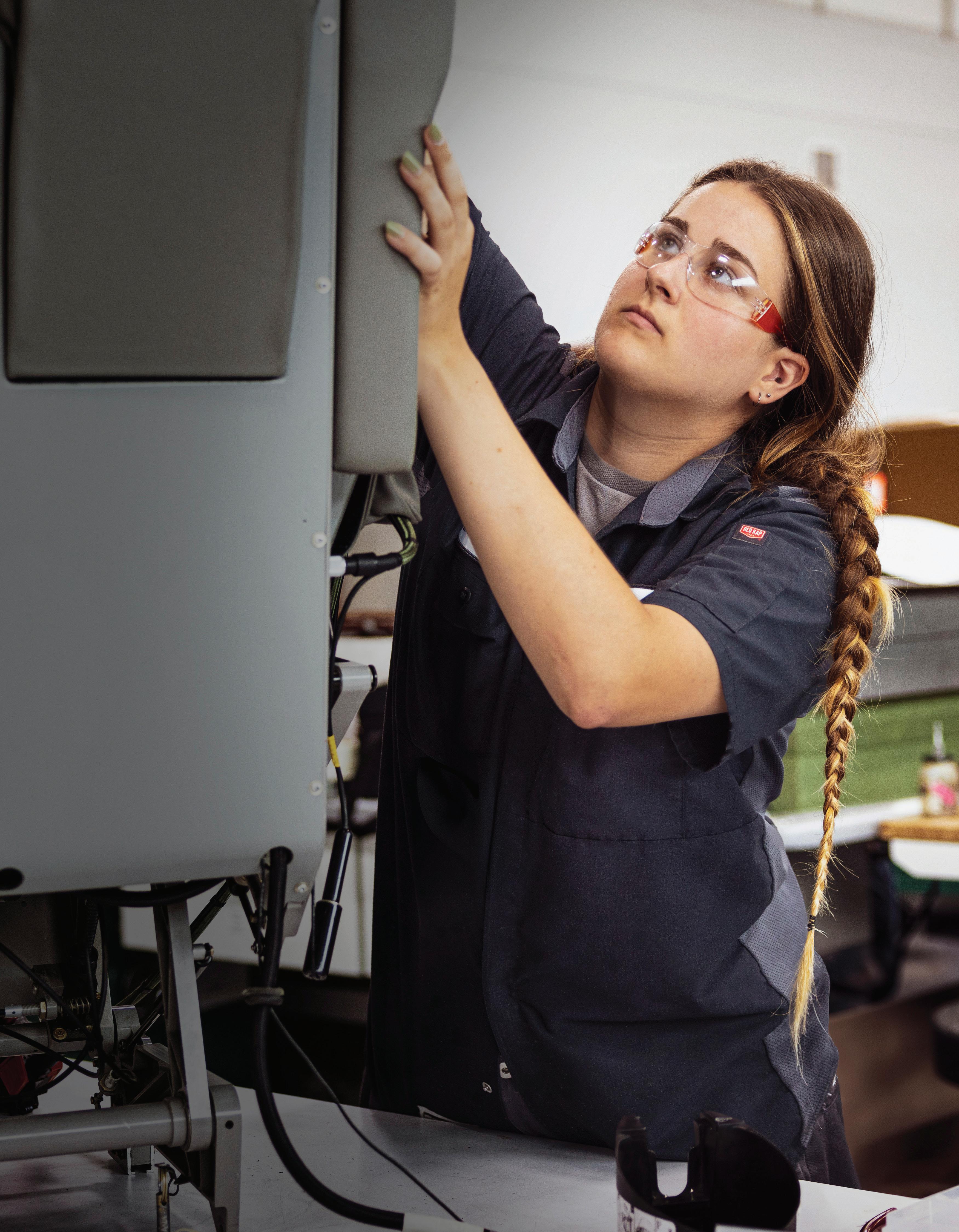
“I love working on aircraft. Every day is a challenge, and all I do and learn keeps my brain active. As I walk through the hangars each day, I feel so lucky to know this is my job!”
Shaylee Wagner, Upholstery Crew Leader
Duncan

Kasey Marie Wilkes’ career trajectory at Envoy exemplifies a dynamic integration of passion, adaptability, and continuous learning. Her evolution from Envoy Aircraft Mechanic to a curriculum developer in the Maintenance Training Program underscores how diverse experiences and an openness to change can drive a successful career.

By Selina Camargo

Kasey’s professional journey began at Envoy as an aircraft mechanic, where she maintained our Embraer aircraft in Abilene, Texas. Kasey was equipped with foundational skills she learned at vocational school but lacked extensive hands-on experience.
“Starting out was a learning curve but Envoy provided the structure and mentorship I needed,” said Kasey. Kasey initially planned to pursue a degree in aeronautical engineering at the Florida Institute of Technology. However, after working as a baker, she was inspired by an aircraft mechanic and decided to shift her focus to aviation maintenance. This change in direction led her to earn her Airframe and Powerplant (A&P) Certificate in 2015.
After seven years at Eagle Aviation Services, Kasey explored various roles in General Aviation Maintenance, including remote positions with charter companies, but didn’t find the right fit. She also worked as a substitute teacher, which sparked her interest in technology and education.
“This phase made me realize my enthusiasm for teaching and technology,” Kasey said. “This realization prompted me to pursue a computer science degree and rejoin Envoy in a role that combined my interests in both fields.”

Kasey’s return to Envoy was marked by her new role as a Curriculum Developer Envoy’s Maintenance Training team. This new opportunity not only drew on her extensive aircraft maintenance experience but also aligned seamlessly with her growing interests and newly gained skills.
“The role was a perfect alignment with my newly acquired skills and interests,” she said. “It felt like a natural progression and a return to an environment that supports professional growth and inclusivity.”
In her new position, Kasey designs and refines educational programs that are crucial to the training and development of Maintenance employees.
“The industry is gradually incorporating more sophisticated tools, such as troubleshooting software and electronic logbooks,” Kasey said. “Even technologies in generative Artificial Intelligence have the potential to enhance maintenance processes and reduce human error, while green technologies will necessitate new training processes.”
She is excited to integrate innovative teaching methods and state-of-the-art industry practices into the training modules and continue her commitment to enhancing the training experience for future technicians.
Entering a predominantly male industry can be tough or women, but. despite these challenges, Kasey has remained resilient. Her advice for navigating such fields is to concentrate on your achievements, seek out supportive mentors, and ensure you work in environments that uphold respect and equality. Kasey’s long-term goal is to establish her own Aircraft Maintenance Technician School.
“I aim to create a program that not only prepares students for exams but also deepens their understanding of the field’s history and significance,”
While Kasey deeply enjoys working on aircraft, she has realized that her true passion lies not just in the hands-on aspects of the job but in fostering a greater appreciation for the craft itself.
As Kasey reflects on her career, she hopes to be remembered for her contributions to both aviation and education. “I aspire to inspire others and share my passion for the industry,” she said.” Her journey illustrates how embracing diverse experiences and remaining committed to one's passions can lead to significant achievements. By adapting to new opportunities and pursuing continuous learning, Kasey's career exemplifies the importance of dedication and provides valuable insights for others navigating their professional paths.
Want to join the Envoy team? Visit envoyair.com/careers




By Mitchell A. Luchansky, M.D.

Since childhood I have had two passions: medicine and aviation. My mother used to enjoy telling the story of how I would stop in the middle of a baseball game with other children and look upward towards the sky anytime an airplane could be heard overhead. I would check out books on WWII aircraft from my junior high school library and memorize the names of the different aircraft involved in battles-whether Allied or enemy. I would be proud naming the aircraft seen on television shows about WWII to family and friendswhether they were interested or not.
In high school I began to request brochures from the United States Air Force. Wouldn’t it be great being a doctor taking care of military pilots? It seemed to check all the boxes. Unfortunately, my parents were divorced, and our financial situation was not very good. I had to give up my dream of becoming a military physician. But my dream of becoming a pilot never faded. It would just have to wait a while until my finances improved. It turns out that wait ended up being about fifteen years.
I attended a local college and medical school to stay near my family and help out as best I could. After graduating medical school, I moved across the country to continue post-medical school specialty training in California. A couple of years into training the time to pursue my dream of becoming a pilot was approaching. I lived in Westwood Village, right in the heart of the UCLA campus. The nearest general aviation airport was Santa Monica Airport. One Saturday morning I drove to the airport and took a Discovery Flight in a Cessna 172. To this day, almost forty years later, I can still recall the feeling in the pit of my stomach when taking off straight towards the Pacific Ocean. I’m sure I had a big silly grin on my face. I was so excited. I felt exhilarated. I had finally done it. I was flying an airplane.
While completing my last year of medical training in Los Angeles, I continued my flight training to pursue a private pilot license. Due to training at an airport just north of LAX, one of the busiest airports in the country, I had the opportunity to hone skills on the radio and become familiar with how to communicate with air traffic controllers in a busy aviation environment. I quickly learned the importance of keeping my eyes out of the cockpit to “see and avoid”. The first time taking off from Santa Monica Airport towards the ocean and seeing


a huge commercial airliner to my left taking off from LAX was fascinating and scary. After about six months of flight training, I earned my private pilot license and became a certified pilot. I was now a physician and a pilot.
After completing my specialty medical training in Los Angeles, I moved back to the East Coast to open a medical practice near my family. I joined a flying club at a nearby general aviation airport to be among other aviation enthusiasts and have an opportunity to fly several different types of fixed-wing aircraft. I enlisted in the United States Air Force Reserves as a flight surgeon based at Andrews AFB (now Joint Base Andrews). I finally got my chance to take care of military pilots! During Desert Storm my medical unit was deployed to a WWII RAF hangar at Upper Heyford, England.
Over the years I have added a commercial pilot license, instrument rating, and even a rotorcraft-helicopter rating, along with becoming a CFII in fixed-wing and helicopter. For many years I owned a Robinson R44 helicopter and flew over much of our beautiful country at 1200 feet AGL!
Over the past several years I have combined my passion for medicine and aviation and opened a private practice office at Flagler Executive Airport in Palm Coast, FL as a Senior AME, HIMS AME, and HIMS Psychiatrist. My dream is complete.








By Joshua Homet

In my parents’ recollection, my interest in airplanes was evident even before I could say the word. They would catch me looking up anytime a small aircraft buzzed overhead or when I caught a quick glimpse of an airliner cruising between the clouds. From the earliest grade school projects asking what you wanted to be when you grew up, I only ever had two answers—professional pilot or storm chaser. As one could imagine, my parents were only really keen on encouraging one of those aspirations. An early memory that really set the hook for me was when my family took a US Airways flight to an extended family event. This was in the pre-9/11 era when flight crews were much more accessible before and after flights. My dad had the forethought to introduce me to the captain as the flight was deplaning. Once I announced my interest in becoming a career pilot, the captain graciously showed me the cockpit and excitedly explained what my future could look like.
Another passion of mine from an early age was music. My parents stressed the importance of participating in music throughout life to me and my two siblings. When the time came in fourth grade, I selected the alto sax. I played this for concert band and participated in the school’s chorale throughout my middle school years. Once in high school, I switched to playing tenor sax


for concert, marching, and jazz band. In my senior year, I was honored to be selected as drum major in the marching band. On the vocal side, I was in chorale, competition choir, and a high school show choir that toured the region, performing over a hundred shows each year. Among my favorite musical endeavors, though, was my three years in a men’s a cappella group. In my senior year, we even got to perform on the grand staircase of the Pennsylvania State Capitol building. For more than a decade, I’ve been playing the Cajon, an acoustic and very portable drum box.
As a sophomore in high school, I had the opportunity to begin my general aviation journey in the iconic Piper J-3 Cub at a nearby private grass strip. This solidified my career goals and made me serious about aviation. In the fall of 2004, I started my Bachelor’s degree at Western Michigan University. I was able to get my tailwheel endorsement back home, flying the Cub during breaks. By summer 2008, I had my degree, commercial single/multi, and my CFI/II. I even managed to get my single-engine sea rating before graduating. If you ever get the chance to fly on floats, be sure to take the opportunity.

At this point, it was time to start building hours. I began with some independent flight instructing, discovery flights, and scenic flights. My first real break came in the form of an aerial survey job. On Halloween 2009, I traded my car keys for the keys to a C-172. It had no autopilot, poorly working

radios, and went through two vacuum pumps during the season—but it was mine. It still seems wild to me that they were willing to give a 22-year-old an airplane, communicating only via phone and email until I brought it back home eight months later. I saw 18 different states during that time, completing photography contracts for mostly local, state, and federal agencies. The flying was very unconventional and proved to be a great teacher of all things aviation. Each contract only provided a location from management, and we were personally responsible for all the lodging, transportation, and aircraft maintenance to complete each project. We gained experience flying over restricted military bases, flying opposite the traffic flow in busy Class B airspace, and encountering all manner of situations that would normally result in a violation from the FAA. The highlight of the season was being asked to fly down to the Gulf Coast in spring 2009. The terrible Deepwater Horizon explosion and oil spill had just occurred, and I was tasked with taking pictures of the shoreline as the oil slick approached land. Once completed, I flew back up the coast to upstate New York and returned the airplane.
many more years of flying around the world in these incredible aircraft.


A few months later, I started the next part of the adventure as a “freight dawg” in Michigan. I went from a C-172 to the right seat of a ~60,000lb-capable twin-engine turboprop with 4,000HP per side. It was a wild ride, to say the least. I finally cut my teeth flying a pressurized aircraft in the flight levels. Years later, the Convair 580 served as my first PIC type and taste of being a captain. This certainly prepared me well for the jet world. I hauled so many strange things throughout my seven years there, not the least of which was the largest saltwater crocodile in the Western Hemisphere named “Baru.” You can still visit him today at the Toledo Zoo.
For the last seven years, I’ve been flying for Flexjet, a fractional ownership corporate jet operator. I started as a first officer in the Embraer Legacy (now Praetor) and, since 2020, have been a captain in the Gulfstream G-450. I still look forward to


Back in 2009, to my surprise, I saw the announcement of a new non-profit organization joining my two passions: aviation and music. The Flying Musicians Association was looking for founding members to help get the organization off the ground. I jumped at the opportunity and signed up right away. In the early grind years, John Zapp (the founder) and I attended various aviation events like Oshkosh to pitch FMA to the general aviation world. We’ve enjoyed playing music with members from around the world, all while being around airplanes. What a great combination! One of the goals from the beginning was to provide scholarships to help pay for flight training. For the last 10 years, we’ve been able to realize that goal by awarding high school juniors and seniors with flight training scholarships through their first solo flight. Please check out the FMA Solo program and donate if you’d like to partner with us in helping invest in these kids’ dreams. For 15 years, I’ve had the privilege of helping encourage the next generation to get excited about these two rewarding passions. My dream of being a “Flying Musician” has been more amazing than that little




Jacob to cover the cost of his flight training. “My parents paid for piano lessons when I was younger,” says Jacob. “That allowed me to perform piano gigs for compensation in high school and college, and that money went straight toward the cost of licenses and ratings.”
Like many pilots, Jacob’s interest in aviation began at a young age. Growing up in Livermore, California, Jacob’s father would take him to the local municipal airport to watch planes from the observation deck. Captivated by each takeoff and landing, this experience eventually led Jacob to pursue his childhood dream of becoming a pilot.
During high school, Jacob began flight training to earn his private pilot license (PPL). Over the next four years, he earned his private, instrument, and commercial licenses from flight schools in the Livermore area. His grandmother funded his college education, allowing
Today, Jacob is an engineer in the San Francisco Bay Area, living close to his family and friends. When he isn’t working or enjoying time with loved ones, Jacob uses his passion and talent for flying to make an incredible impact with Angel Flight West (AFW), an organization that connects volunteer pilots with patients in need of distant medical care.
Renting Cessna 182s and 206s from Advantage Aviation in Palo Alto, Jacob flew his first AFW flight in 2019 and has since completed 28 more missions.
“I heard about AFW shortly after getting my private pilot’s license,” Jacob recalls. “I loved the idea of flying longer trips, and it allowed me to engage in a customer-facing role. The experience with AFW so far has been exactly as advertised—I am thrilled to lend a hand by flying missions.”

Jacob flew a mission for campers Marisa and Jaden, bringing them home after their week at
By Jessica Hayes
Each day, volunteer pilots donate their time, talent, and resources to ensure patients have access to medical care across the West. Since the organization was founded in 1983, AFW has completed more than 100,000 missions, serving nearly 25,000 unique passengers.
During the summer months, AFW also partners with camp organizations to fly children—including young burn survivors, children navigating life-threatening illnesses, and deaf children—to specialty programs tailored to their unique needs. When reflecting on his angel flight memories, Jacob reminisces about a mission he flew for sibling campers Marisa and Jaden, bringing them home after their week at Lions Wilderness Deaf Camp. “Each family member was deaf or hard of hearing,” says Jacob. “Their mother signed and spoke, ‘Thank you so much’ to me on the ramp at Livermore Airport. It was the most beautiful sentence ever spoken to me.”
Speaking of the loved ones who have helped him along the way, Jacob says, “It’s clear when I retrace my steps to the beginning of my pilot training journey, it was the generosity of my family that made it possible for me to do what I do today. I’m just one general aviation pilot who had the opportunity to join AFW’s cause.”

“I am thankful to be part of the organization.”
AFW needs volunteer pilots to join their charitable aviation cause. You choose when and how often you fly, all while helping patients on the runway to recovery. Learn more at http://angelflightwest.org/ pilot-page or email volunteerinfo@angelflightwest.org for more information.



Aircraft Landing Systems 2361 S. 1560 West Woods Cross, UT 84087 tech@matcoals.com 801-335-0582 801-335-0581 Fax




The introduction of Advanced Air Mobility (AAM) is expected to revolutionize the aviation sector and reshape how we view and utilize urban transportation. As cities grow and traffic congestion worsens, AAM offers an innovative solution that could dramatically transform both modern aviation and urban mobility.
At the core of AAM are electric vertical takeoff and landing (eVTOL) aircraft. These vehicles are designed to alleviate urban traffic by providing an alternative mode of transportation that bypasses traditional roadways. With eVTOLs, urban air travel becomes a reality, offering faster, more cost-effective, and environmentally friendly options for cargo and commuter transportation.
The potential impact of AAM on the aviation industry is immense. In addition to enhancing existing transportation systems, eVTOLs are expected to seamlessly integrate with current infrastructure, connecting cities, airports, and suburban areas. This integration could significantly reduce travel times and boost the overall efficiency of the transportation network.
Environmental sustainability plays a crucial role in the adoption of AAM. The aviation sector’s carbon footprint has long been a concern, but eVTOLs provide a solution to mitigate this issue. Powered by electric propulsion, these aircraft emit no in-flight emissions, leading to improved air quality in urban areas. By reducing ground traffic congestion, eVTOLs can further decrease overall emissions, contributing to greener and more livable cities.
Public opinion and acceptance are critical for the successful implementation of AAM. Safety remains a top concern for many,


By Jerry Quandt

making it essential to address these worries through rigorous testing, certification, and transparent communication. By ensuring eVTOLs meet stringent safety standards and demonstrating their reliability through controlled pilot programs, stakeholders can build public trust and confidence in this new technology.
The economic impact of AAM is equally significant. The development and deployment of eVTOLs are expected to create numerous job opportunities across various sectors, including manufacturing, maintenance, operations, and logistics. Additionally, the construction of vertiports—dedicated takeoff and landing zones for eVTOLs—will require new infrastructure, further driving investment and economic growth.
Governments and regulatory agencies are key players in the development of AAM. Establishing clear regulatory frameworks and promoting public-private partnerships are essential to ensure the smooth integration of eVTOLs into urban environments. By collaborating with industry stakeholders, governments can create policies that encourage innovation while safeguarding public safety and environmental sustainability.
In summary, the integration of Advanced Air Mobility into urban settings represents a transformative shift for the aviation industry. The increasing presence of eVTOLs in the sky offers a wide range of potential benefits, from reduced traffic and emissions to enhanced connectivity and economic growth. The aviation sector is on the brink of a new era, where the sky becomes a gateway to limitless possibilities.

Embracing AAM opens the door to a more efficient and sustainable future in aviation while also improving urban mobility. The path to widespread adoption of AAM will require collaboration, innovation, and a commitment to overcoming the challenges ahead. However, the rewards of this endeavor promise to redefine the aviation industry and revolutionize urban transportation for generations to come.
Jerry Quandt is a recognized expert in Advanced Air Mobility (AAM) and future mobility, with a profound understanding of the integration of cutting-edge technologies in the aviation sector. As the founder of QuandtMLeap Consulting, Jerry has led numerous initiatives that leverage AI, robotics, and drone infrastructure to advance the field of AAM. He has collaborated with prominent institutions across the world to drive forward-thinking Smart Mobility projects. Jerry’s extensive experience and strategic vision make him a thought leader in AAM, influencing the development and implementation of innovative mobility solutions that are shaping the future of transportation and logistics.
Linkedin Link: www.linkedin.com/in/jerryquandt/ www.quandtmleap.com
By Daniel Ford
There are a few people in this world who make it their duty to break barriers. Captain Lou Freeman is one of those people. Lou spent much of his childhood in Dallas, Texas, and was one of the first Black students to integrate a previously all-white high school. As a child, this was not something Lou wanted to do, but it ended up benefiting him later in life through the new experiences he was exposed to.
He went on to attend East Texas State University, where he was part of the Air Force ROTC. It was here that Lou realized for the first time that he wanted to be a pilot. He took the Air Force AFOQT Test and scored very well in almost all parts of the exam, except for the pilot portion. In the 1970s, it was uncommon to see Black pilots, so Lou had never considered it a possibility. However, after seeing his score, he was motivated to improve on that portion of the AFOQT. That motivation led him to pursue flying as a career, eventually joining the Air Force, where he had a very successful career. Lou said he never had any doubts once he set his mind to becoming a pilot. He had no plan B and refused to fail.
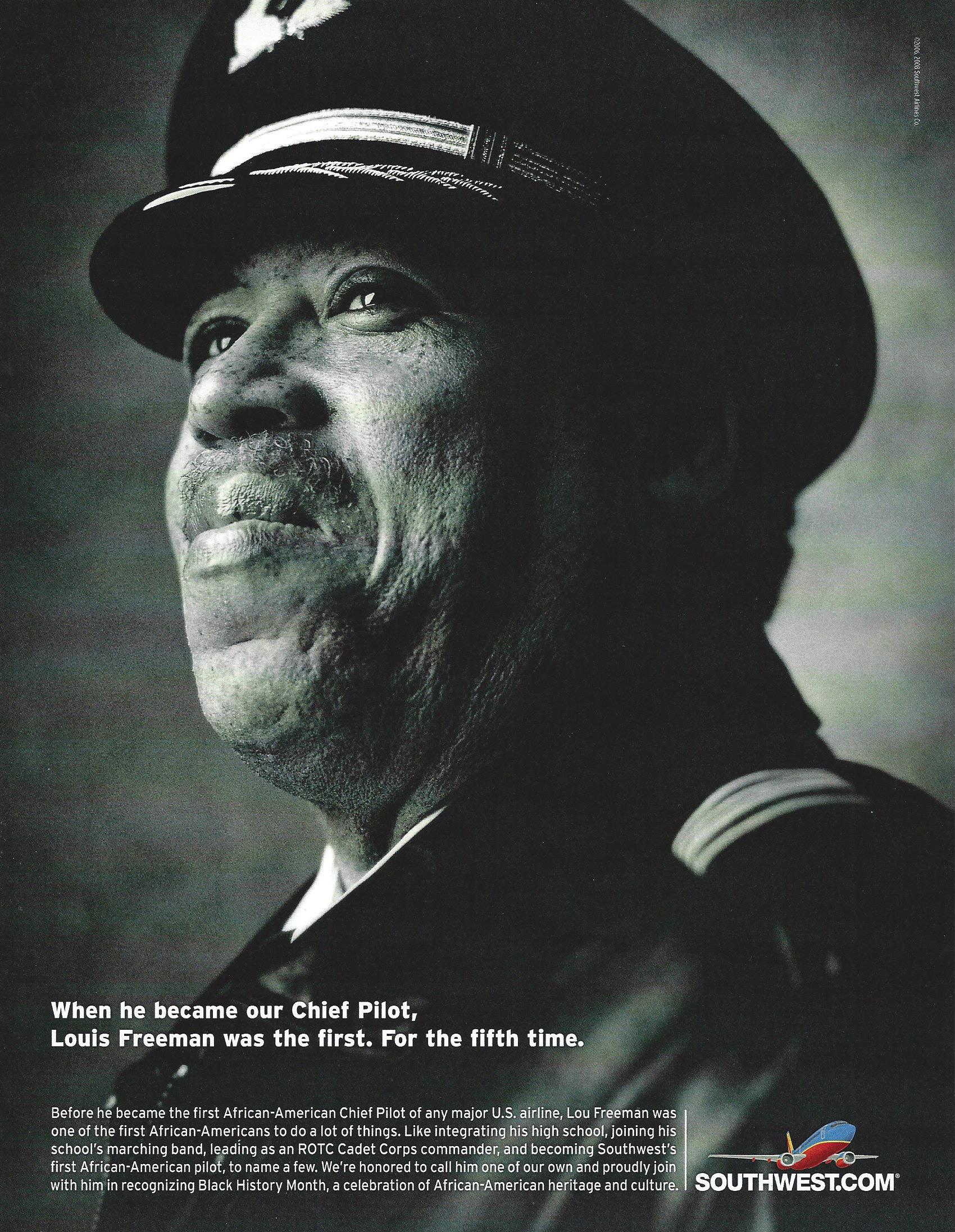
Lou’s passion for flying eventually led him to Southwest Airlines. He was concerned that as he advanced in the Air Force, he would spend less time in the cockpit and more time on the ground. Lou became the first Black pilot for Southwest and the first Black chief pilot for any major U.S. airline. Although his role as chief pilot
at Chicago Midway Airport often kept him in the office, Lou consistently picked up flights, flying more than any other chief pilot at Southwest simply because he loved it.
Lou’s favorite memory from his career was flying Rosa Parks’ remains and her family and friends to Montgomery, Alabama. He brought his own family along so they could appreciate the sacrifices others







made for them. Upon departing Montgomery, Lou circled the city and then rocked the wings as a wave goodbye, thanking everyone in Montgomery and the trailblazers who came before him.
Lou retired from Southwest Airlines in 2017 but never stopped being a positive influence in the aviation world. His desire to share his experiences with youth continues to inspire him today. Growing up in the 1960s, Lou had to overcome many obstacles to achieve what he did. With no one to turn to for advice during his youth, he now takes it upon himself to be that voice for young people. Lou feels blessed to have accomplished everything he did, and now he helps others realize their dreams by working with Tuskegee NEXT. Tuskegee NEXT helps underrepresented youth earn their Private Pilot’s License and Drone License at no cost to them. Lou wants to show adolescents, who may have never considered aviation as a possibility, that they can achieve anything they set their minds to.
The life of Captain Lou Freeman shows us that anything is possible. Barriers can be broken, and anything can be achieved with hard work. Lou continues to inspire pilots in training and the flight instructors at Lewis University, where he is currently the Executive Director of Flight Operations. He is admired by everyone at Lewis and continues to help the next generation of pilots take the next step in their careers.


Ava Watson of New Orleans has always been up for adventure as she loves roller coasters, zip-lining, and airplanes. On March 30, 2024, Ava was up for another kind of adventure when she competed and was crowned Miss Louisiana Teen USA 2024 at the Jefferson Performing Arts Center in her second pageant competition ever. She has been using her year of service to Louisiana to promote her personal platform on young women in STEM and specifically, aviation.
Ava is passionate about aviation, actively learning to fly in her mother’s 1978 Grumman Tiger airplane
out of Lakefront Airport (KNEW) in New Orleans, Louisiana. She loves the plane that they call “Dolly” because the cockpit opens, which gives the pilot both an excellent vantage point and a break from the heat of the bayou state. Her favorite flight pattern is known as the “river run” where pilots follow the Mississippi River and get one-of-a-kind views of the river, parish industry, and finally turning towards and crossing through the picturesque City of New Orleans towards KNEW. She loves flying over her neighborhood and trying to find her house nestled among the trees in the historic Uptown New Orleans area.
She’s a proud member of the NOLA 99s, an organization of women pilots of which Amelia Earhart was elected the first President of the national organization in 1931. Ava enjoys participating in the group’s activities and learning from experienced women pilots. She is also a member of the Experimental Aircraft Association and Women in Aviation International.



By April L. Watson
Aviation runs in her family, with her great-grandfather being a lead engineer on the Grumman F-14 Tomcat for the Navy, her grandfather being a private pilot, and her mother also sharing a love for flying. Ava will be pursuing a degree in business and aviation, and eventually a career in commercial aviation.
One of her favorite memories is visiting her mom’s hometown of Anchorage, Alaska last summer, and specifically, Lake Hood Seaplane Base. It’s the world’s largest and busiest seaplane base. Ava was awed by the number of colorful planes, which were striking against the beautiful mountain landscape of
Ava has been a guest speaker at the Civil Air Patrol and made guest appearances at several aviation days where volunteer pilots take kids and teens on airplane rides to spark their interest in aviation. She speaks on training, challenges, the impact of aviation on Louisiana’s economy, and aviation careers. Ava hopes to shed light on the importance of aviation to the state’s economy, the numerous opportunities it can bring, and the career opportunities available to the next generation of pilots, aerospace engineers, aircraft mechanics, and airport managers.
"I'm really encouraged to see so many young women pursuing and succeeding in flight training"
Jeanie Janczewski, Ava's flight instructor with Gulf Coast Aviation at KNEW in New Orleans is also one of Ava's mentors.





























Provides a solid foundation of aeronautical knowledge and piloting skills expected by professional aviation organizations and necessary for success in the aviation industry. The Professional Flight degree quali es for the a ainment of FAA Restricted Airline Transport Pilot (R-ATP) certi cation.
Focuses on the business knowledge needed for success in the airline, airport, and aviation industries, emphasizing general management and comprehensive understanding of all aspects of aviation operations


STATE OF THE ART TRAINING FLEET
Over 40 aircra in our growing eet
• Piper PA-44-180
• Cessna 172S
• DCX MAX & Frasca Simulators
• Airbus 320 Simulator
Be a part of the Auburn Family!
• 6+ Career Pathway Programs
• 10 Aviation Student Orgs.
• 61% Out of State
• 800+ Aviation Students
• On-Campus Housing
• Total University Enrollment:
33,000 Students













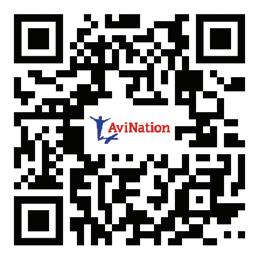


By Ryan Walsh
Drones are one of the most rewarding and challenging industries I could have found myself in. Having started my career in the 75th Ranger Regiment, it quickly became clear to me that uncrewed aerial vehicles would be a massively disruptive technology—on par with the cell phone and the internet. I believe there is no other industry

When people think of aviation, they imagine planes and helicopters carrying passengers across the world, which has become a mainstay in our society. But drone and aviation careers hold the same possibilities. I came from a rough childhood and didn’t always have my basic needs met, so I joined the military. It seemed like the best place to get a fresh start, but when I left the military, I was just as lost as when I joined. It wasn’t until I immersed myself in the world of drones that I realized a career in aviation could take me places I never thought possible.


After reading everything I could find about drones and learning all I could about the industry, I filed my first patent application for drone technology in 2013. Now, I am the CEO of a drone company at the forefront of technology. If you had asked me 25 years ago if I thought this was possible, I would have emphatically said no. But here I am, much to my own surprise, with 34 granted patents for my drone-related inventions and customers all over the world. I get to meet fascinating people and make a true difference in the world. The impact is visible in real time—whether it’s connecting a village to a hospital or saving an hour of traffic by flying a meal over a bay. The results and impacts are tangible and incredibly meaningful. That’s an hour we just saved a mom with her kids in the car, or time we gave a nurse who has to travel by boat, car, and on foot to bring supplies to remote villages. That mom can now spend more time with her kids, and that nurse can now spend more time with her patients. Seeing that kind of real impact makes everything worthwhile.

Aviation is by no means easy, and it’s often so challenging that it’s frustrating, but I couldn’t imagine myself working on anything else.

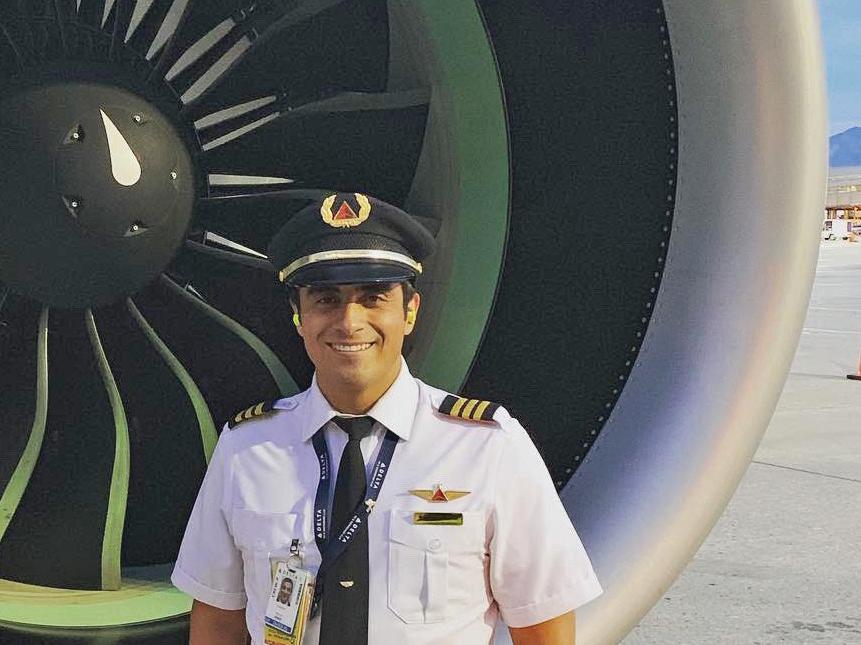
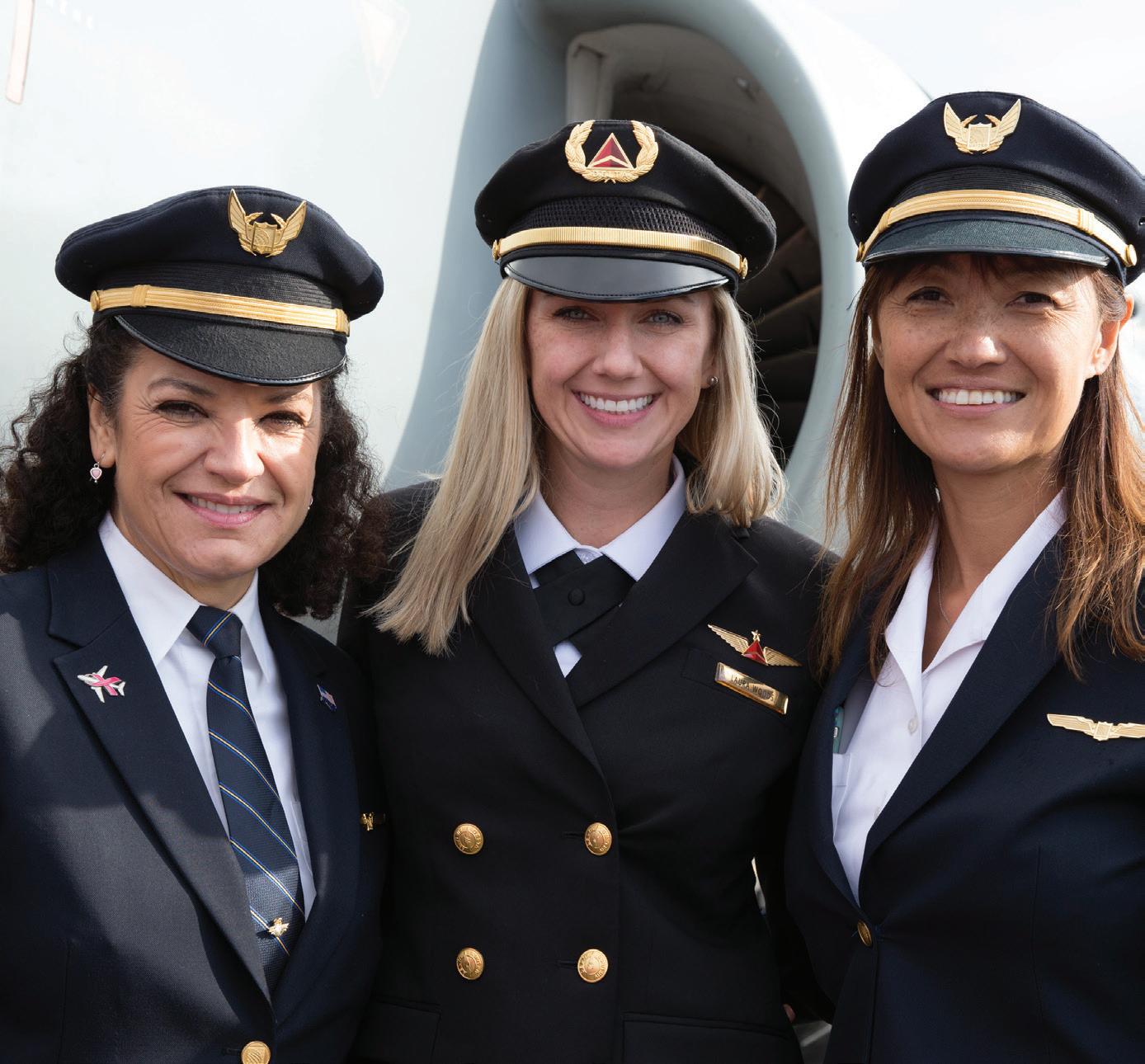

By Nancy Coll

In a recent interview, we had the privilege to sit down with DeLorean Andrews, an accomplished aircraft instrumentation electrician and an inspiring individual who has risen through the ranks in the aviation industry. From troubleshooting electrical systems in Chinook helicopters to pursuing his dream of becoming a licensed pilot, DeLorean shares his journey, insights, and advice for young people. His story is one of perseverance, determination, and the power of education, providing a motivational blueprint for anyone aspiring to reach their goals despite the odds. Here’s an in-depth look into DeLorean’s career, his views on the future of aviation, and his personal reflections on life.
What skills are you working on now and why, if you can talk about that?
Delorean: The skills I’m working on now are all electrical. My title is aircraft instrumentation electrician, which means I handle all the avionics inside the Chinook helicopter. I make sure that the avionics equipment works. If they don’t work, we troubleshoot to fix them. Mostly, it’s all public knowledge. I work with the fuel systems, navigation—pretty much the whole electrical system on the Chinook itself.
In what direction do you see jobs in aviation going in 2034?
Delorean: Aviation? Well, I know there’s a shortage of pilots, mechanics, and electricians right now. So, I do see that there’s going to be a shortage of skilled labor in that sector in aviation.
What’s your advice to young people?
Delorean: My advice to young people is to follow your dreams. And, if you don’t have a dream, start to research what it is that you might like and what you may love doing for a living. You want to do what you love. I definitely think education is the most important part of your tool bag. If you have education, I believe that can take you further than any dream could because that’s the stepping stone. That’s what you build off of—your education. Experience and mentorship are important also.
What would you tell your twelve-year-old self now?
Delorean: Oh, that’s a good one. I would tell my twelve-year-old self to stay consistent, stay positive, and to build your mentoring network with people who can get you through some of your tough times. I think having a mentor is important for every young person.
What’s the most important skill that you’ve learned so far?
Delorean: Patience. Being able to troubleshoot a problem and not giving up. Sometimes when you’re looking for a problem electrically, it’s hard because it’s not physically broken. You can’t see it like you would if you took a broomstick and chopped it in half. That’s physical; you can see that it needs to be mended. But electrically, sometimes you’re chasing a theory. It can get hard, and you can lose your motivation when you’re chasing a problem that you can’t see. You have to just keep testing. So, I definitely think it’s about being able to persevere and having the endurance to get through things.
What do you do to work on your patience? What helps you build that skill?
Delorean: Working on patience involves giving grace. As humans, we’re not perfect. We make mistakes. When you’re managing multiple humans, as someone who manages employees, it’s not always easy to work with different personalities. So, I think that how I work on patience is by giving grace and understanding that not everyone is you. The way you would do things is not how someone else would do it. You have to let people work the best way that they know how. Sometimes it takes patience and grace to let people make their mistakes or learn from using the skills that they may have.

If you could travel anywhere in the world, where would you go?
Delorean: I would love to visit Africa. I am AfricanAmerican, and I’ve always been in the United States. I’ve stepped out of the United States a few times, going to the Dominican Republic and Mexico, but I’ve always been drawn to Africa. I would like to go to the Serengeti, to be specific. Growing up, I always watched National Geographic, and I’ve always wanted to see the animals roaming free. I would love to visit the Serengeti!
What is your connection to John DeLorean?
Delorean: My connection to John DeLorean? Well, the exclusive story would be that my father and mother were in the hospital trying to name me, to come up with a name out of so many different names like Kevin, Darryl, Michael, etc. They eventually saw John DeLorean in the news, going to court. While my dad was holding me, he looked up and saw John DeLorean on TV and asked my mom, “What about DeLorean?” She said she liked the name. So, my connection is being named after the vehicle he created, designed, and manufactured.
What do you see in the US as far as job markets, any geographic areas that you think might benefit from things that you see as possibilities?
Delorean: I think every city has its own unique sector of engineering and expertise. I believe that if you give people the tools they need to work, they could get an assignment or a job in any city. From my experience, people love to work, people love to provide for their families. I believe that if you place an aircraft manufacturer in, let’s say, Houston, Texas, it will prosper. One thing I’ve learned is that a lot of folks don’t know about aviation. Some just think aviation is hopping on a plane when they take a trip from Miami to Philadelphia. They don’t know that those planes are actually built here in the United States. Some folks


think those planes are built elsewhere. Aviation is just such a unique sector that it’s overlooked at times because of the lack of education or exposure to it at a younger age.
Of what are you most proud?
Delorean: That’s a very good question. I never really thought about that. I’m most proud of my experiences. I feel like if I never went through the things that I went through in my early stages of life, I probably wouldn’t be who I am today. So, I’m most proud of perseverance, being able to overcome obstacles. I’m proud of being self-motivated. For a lot of folks, it’s hard to be motivated in a negative situation. So, I’m just thankful and proud of where I’m at today, where I built my career to be, and what my life became. I think that’s probably what I’m most proud of right now.
Could you share a general pathway story of how you first got any kind of bug for what you do today?
Delorean: I would have never thought about it in a million years, seriously. I didn’t grow up in an aviation family or a military family. I do have military family members, but my immediate family never had any type of aviation experience or exposure. No one in my family is a pilot. I will be the first, as I’m currently getting my pilot’s license as a student. I do have a cousin whom I inspire. He’s getting his commercial pilot license. So, it’s kind of an unspoken competition between us to be the first in the family to receive our pilot license.
Backing up a little bit, I come from a small town, Dayton, Ohio. My mother was in college at the time, attending Dayton University. She got pregnant during her senior year and was on the verge of not having me because she was in the middle of school. My grandmother stepped in and suggested she have the baby and bring me to Miami while she finished her senior year. This way, she could finish school and
then have her child. So, coming from Dayton, Ohio, I relocated to Miami at a very young age and grew up mostly in Miami. I spent a few years in Dayton and later a few years in Philadelphia because my grandmother relocated from Miami to Philadelphia.
I never thought in a million years I’d be in aviation. It all started with, and there’s an article Boeing wrote about me, but I’ll give you the short version of it. When I moved to Philly, I knew no one. I was about 21 or 22, so I needed a job that summer while visiting my grandmother. There was a hiring fair at CareerLink, where representatives from Delaware County Community College were scouting for talent to create a pipeline from Delaware Community College to Boeing. As a member of Career Link, I was able to attend the interview.
So, I came to visit Philly and never left. I got into this program at Delaware County Community College. The program was ten weeks long, 40 hours a week, and very intense. After we graduated, we were given an interview at Boeing to be sheet metal workers and fabricators.
That’s how my story started. I began as a fabricator doing sheet metal work. Within my union, the International Association of Machinists and Aerospace Workers, I climbed the ladder to become a mechanic, then an aircraft electrician, and now an instrumentation electrician, which is the highest electrical position you can achieve within my union.
What gave you the idea for flying?
Delorean: It’s actually funny. I watched Red Tails, and that’s what sparked it. Watching the movie, I said, “You know what? If they can do it, I can do it.” At the time, I was doing pretty well in my career and just being exposed to aviation further inspired me. As we know, getting your private pilot license is expensive, so I wasn’t initially in a financial situation where I could afford it. Once I was able to put some funds together, I decided to go for it.
I love challenging myself. For instance, I have a motorcycle license, which is a funny story. I wanted to get my motorcycle license just to see if I could do it. I had never driven a motorcycle a day in my life, but I took the class, passed, and got my license. Aviation is kind of the same for me; I just want to see if I can do it.
Are you a musician like your father?
Delorean: My father left me and my brothers his bass guitars, and I started playing. I did learn to play, “Get Down on It” by Kool & the Gang. That was the song he taught me before he passed. I can play that, but that’s about all I can play. I wish I would’ve learned more, but you know, his spirit lives through me, and I do plan on one day playing that song at his gravesite. And, just so you know, music is a part of me because of him. I wish I had a lot more time to learn from him, but I know he’s looking down on me. I’m doing pretty well, so I thank him for who I am today.

What do you want to do with your flying?
Delorean: I plan to take my first cross-country flight from Philadelphia to Dayton, Ohio to honor my dad. I want to circle my dad’s gravesite while flying into the Dayton Airport. Then, I want to go and lay his favorite Ohio State jacket on his gravesite.


For more information contact the Office of Admission at admission@lewisu.edu or call (815) 836-5250.
Innovative, forward-thinking programs will prepare you for the careers of today and those to come.
With ongoing advances in technology, your dreams for your future should have no limits. Lewis began in 1932 as an aviation technical school. Today, Lewis’ nationally ranked, FAA-approved, aviation programs meet the demand for the current pilot and maintenance shortage. Boeing forecasts a shortage of 617,000 pilots and 679,000 maintenance technicians by 2035. With active corporate partnerships at O’Hare and Midway International Airports, and our own regional airport on campus, you will be totally immersed in the aviation industry.
Aviation and Transportation Studies Department
BACHELOR’S DEGREES
• Air Traffic Control Management
• Aviation Administration
• Aviation and Aerospace Technology
• Aviation Flight Technology
• Aviation Maintenance Technology
• Unmanned Aircraft Systems
MASTER’S DEGREE
• Aviation and Transportation Studies
ALL UNDERGRADUATE MAJORS IN AVIATION ARE ELIGIBLE.
B.S. to M.S. in Aviation and Transportation
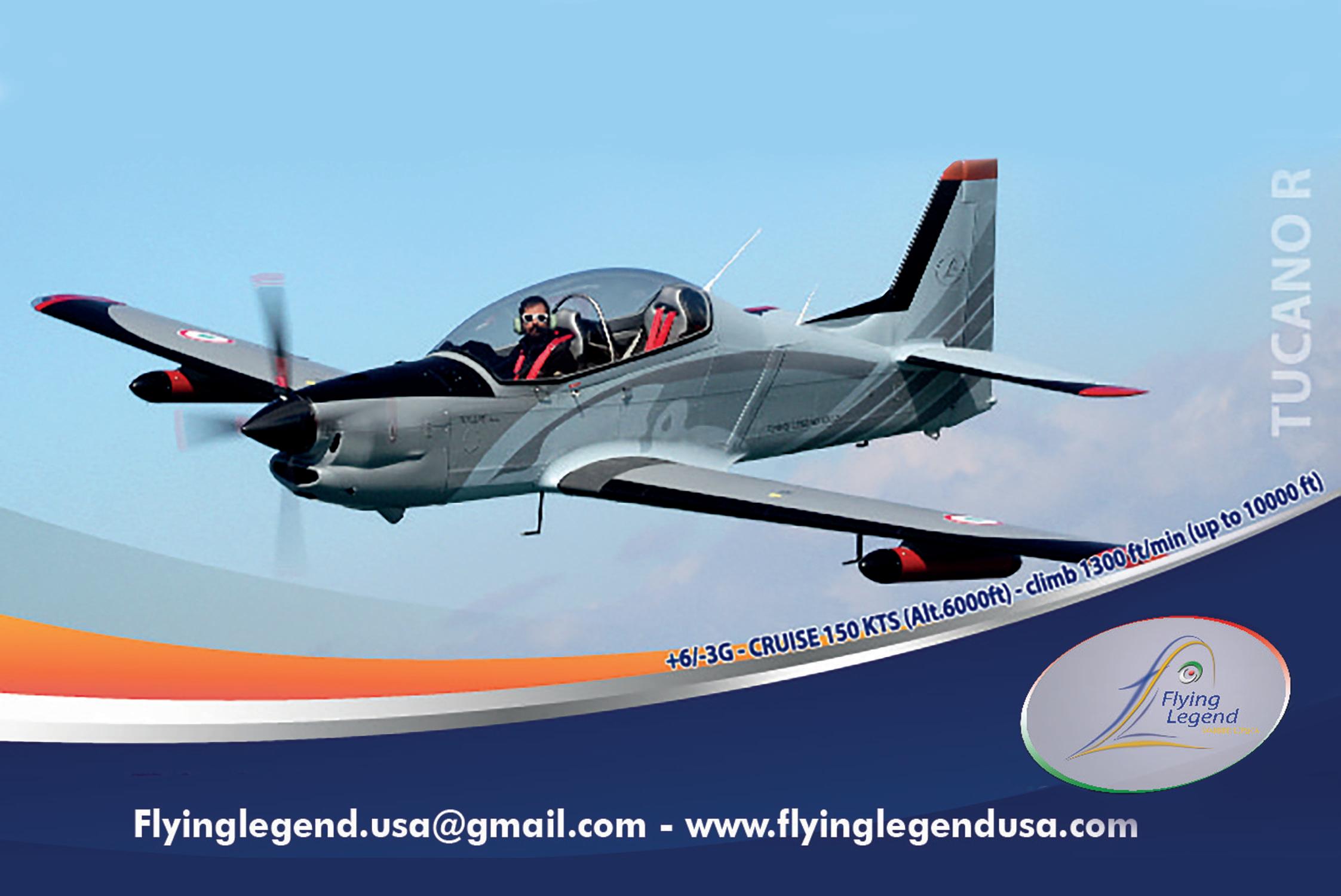

For many new college students, myself included, there’s often a planned career path they want to follow. Sometimes it works out, and other times, nothing goes as expected. In my case, my plan to become a mechanical engineering student was put to rest before I even stepped foot on a college campus. However, despite a prolonged period of confusion and uncertainty, I’ve reached great heights in a field I never expected to be in—aviation and unmanned aircraft systems.
By Kamden Moore
I’ve always loved cars, even before I could speak, and I thought working with them would be the only path that would satisfy me. I dreamed of starting my own parts company for race cars and even racing professionally. However, opportunities were limited in my small farm town in northeast Louisiana. My family wasn’t wealthy, which further restricted my options. But two things always pushed me to see past my limitations—my intelligence and stubborn determination. These qualities have been crucial to my success in my college aviation career. None of this came easy, especially since I started with no prior knowledge of anything related to aviation. I had never been on a plane or even to an airport!
One of my first hurdles was figuring out what to do after high school. I applied to Louisiana Tech as a mechanical engineering student but wasn’t accepted for reasons still unknown to me. The University of Louisiana at Monroe offered me a great deal of scholarships, but I had no idea what to study. The school is primarily known for pharmacy, nursing, therapy, and biological sciences. During my career search, I stumbled across an Unmanned Aircraft System Management program. I had a slight interest in technology systems, and this was the only program with tech connotations besides computer science. I also saw that the drone industry was rapidly expanding, with endless applications. So, I made the big decision to study drone systems. The classes were fascinating, thanks to the
excellent teaching of my professors, David King and Darrion Jenkins. As time went on, I realized that the field I was entering would change the world tremendously. Many people at my school didn’t even know the program existed or what it meant.


During my sophomore year in Spring 2024, my professor Darrion informed us about an internship opportunity at Hartsfield-Jackson Atlanta International Airport, the world’s busiest and most efficient airport. They were looking for students studying in the drone field to start a drone team at the airport. I applied, almost as a joke, not expecting to make the cut. I felt unqualified and unready for such a phenomenal opportunity. I asked my professor for help with revising my resume and putting in a good word for me, for which I am extremely grateful. The Airside Operations assistant director, Geoffrey Gaskin, also attended ULM (formerly NLU), which may have helped too. To my surprise, I was selected for an interview, and from there, momentum carried me forward. One interview led to another, and one day, I got the call offering me the internship of a lifetime!
The onboarding process was a bit confusing at first, but with the help of Tom Dobberke in HR at the airport, I managed to get everything secured. I imagined the process would be overwhelming and intimidating, and in some parts, it was—things like finding housing, traveling, and managing expenses. However, once again, my professor Darrion and my family helped me a great deal with preparation and finding options.
Once I arrived in Atlanta, it was a whole new world, and it took some time to adjust. I essentially lived in the city for two months on my own as a 19-year-old. The internship experience was nothing short of insightful and amazing. The Airside Operations team was very welcoming and helpful with all the questions I had. Since I had never been to an airport before, I was blown away when we went out on the airfield for self-inspections. I was on the

runways of the world’s busiest airport, working with the people who run it! My bosses, Geoffrey Gaskin and Darrin Barth, were phenomenal mentors who made me feel at home despite being seven hours away from it. They included me and my coworker Amy Martin in important meetings with other airports, calls with various Department of Aviation divisions, and much more. Outside of these events, our main duties were to create structure within the UAS program they were looking to start and to assist in drone operations on the airfield. Amy and I pooled our drone experiences and insights, resulting in the creation of a drone operation checklist, which went through many revisions but is now officially part of ATL Airside Ops’ SOP list. My favorite duty was assisting with the 2D and 3D mapping missions that were shown to the P&D team. Our mini fleet of drones is entirely DJI products, and ATL hopes to expand this in the future.
The internship flew by, and I was a bit bummed to leave. However, I didn’t leave empty-handed, as I carry with me the many skills I acquired and the numerous connections I made. I gained confidence in team communication, management, and critical thinking. I’m forever grateful to the City of Atlanta, my professors, and most importantly, my family and friends. My main drive in life is my younger brother Brailon; I just want to be a good example for him and show him that anything is possible. There are no limits if you’re willing to venture into the unknown.

In the world of aviation, the journeys of young pilots are often marked by determination, resilience, and the relentless pursuit of their dreams. In this series, Hope for Those Confined to the ‘No-Fly Zone’, my goal is to highlight some of their amazing stories to inspire other aspiring pilots who are facing financial challenges in funding their flight training.
Among these inspiring individuals is Da’Nyra Richardson, a 21-year-old woman breaking barriers and making her mark in the skies. Her remarkable journey, the challenges she has overcome, and the strategies she has employed to fund her flight training serve as a beacon of hope and motivation for aspiring pilots everywhere. Da’Nyra’s story showcases that with passion and perseverance, the sky is not the limit but just the beginning.

At just 21, Da’Nyra is already an inspiration in the aviation community. As a woman of color and a privately rated pilot, she is currently working toward obtaining her instrument rating, with the ultimate goal of becoming a commercially rated pilot and joining the United States Air Force. Da’Nyra’s passion for aviation was sparked during a career day in ninth grade, leading her to dream of a career in the skies.
At 17, Da’Nyra took her first discovery flight, an experience that cemented her desire to pursue aviation. After high school, she enrolled at Polk State College, majoring in Aerospace Sciences, Professional Pilot Science, and
By Tekila Brown


began her flight training as a private pilot. Da’Nyra funded her training through the James C. Ray Scholarship, administered by the Central Florida Aerospace Academy Foundation in Lakeland, Florida. This scholarship, totaling $12,500, helps Central Florida students achieve their goals of becoming rated pilots.
In addition to the James C. Ray Scholarship, Da’Nyra received a $12,000 scholarship from the United States Air Force called "Aim High" which opened up the door for her to receive another scholarship of $12,000 called "You Can Fly". Her involvement in the Reserve Officers Training Corps (ROTC) helped her connect with Air Force recruiters and student service liaisons, allowing her to secure this funding. Today, she has approximately 100 flight hours and continues to find ways to finance her training, including working as a work-study participant in the Aerospace department at Polk State College.
When asked for advice for aspiring flight students, Da’Nyra emphatically said, “APPLY FOR SCHOLARSHIPS NOW! LIKE RIGHT NOW!” She stressed the importance of funding in flight training, as without it, opportunities to learn are limited. Da’Nyra acknowledged the challenges of the journey but advised students to always “do your best” and ignore naysayers. “Don’t ever let someone tell you what you cannot do. Put your whole heart into it—that’s important,” she emphasizes.
Congratulations to Da’Nyra and her remarkable journey!



By Nancy Coll
In an ever-evolving aviation industry, where the demand for skilled mechanics is higher than ever, one entrepreneur is on a mission to revolutionize the way these professionals are treated and valued. With a rich background in aviation, entrepreneurship, and leadership, Suresh (often called “SoFresh”) is not just focused on meeting the growing needs of the industry but is committed to elevating the standards for the people who keep aircraft in the sky. In this insightful interview, Suresh shares his journey, the inception of Jets MRO, and his vision for a more engaged and appreciated workforce in aviation maintenance. Through transparency, employee ownership, and a culture-first approach, Suresh is setting a new benchmark in the MRO sector, proving that a successful business is built on the foundation of its people.
Q: Can you tell us a little about your background and how you got started in aviation?
Suresh: I was born and raised in Miami, with aviation being a significant part of my life from the beginning. My father, an immigrant, had been in aviation his entire life and started a repair station in South Florida. Growing up, I was immersed in the aviation sector, especially in maintenance, engineering, and manufacturing, including rotorcraft. After completing my undergraduate degree at Florida State, I intended to return to work in the family business. However, due to the tough market conditions post-9/11, my dad decided to close the business, which led me to Dallas in 2009. My brother, an avid engineer with experience in the aviation industry, had a unique vision for independent engineering services for operators, which eventually became AQRD, a company I helped scale up.

Q: What is AQRD, and how did it evolve under your leadership?
Suresh: AQRD started as an engineering service company focused on providing independent solutions for operators who didn’t want to rely on OEMs for repairs and alterations. We began with a strong emphasis on composites, metals, and structures. The company grew to manage engineering functions for major carriers, providing a fast, hands-on service model that operators loved. We then expanded into component repairs with our repair station, where we could write our own engineering and execute repairs live. A significant part of our culture was built on the promise of avoiding layoffs, which led us to diversify into military projects, modifying older supersonic jets with modern technology.

Q: What motivated you to start Jets MRO, and how does it differ from other maintenance organizations?
Suresh: After stepping away from AQRD to focus on mergers and acquisitions, I noticed a significant need in the industry, particularly in the maintenance sector. Post-COVID, the demand for maintenance, especially in the business jet and military markets, skyrocketed as older jets were flown more frequently due to a lack of new aircraft. The existing MRO infrastructure wasn’t keeping up with this demand, creating an opportunity to establish a professional MRO business. I started Jets MRO with the goal of elevating the standard of how mechanics are treated, offering profit sharing, family benefits, and a transparent culture from day one. My aim is not just to meet the demand but to create a workplace where mechanics feel valued and can thrive.
Q: How do you plan to address the mechanic shortage in the industry?
Suresh: The shortage of A&P mechanics is a significant challenge. Right now, I could hire
30 experienced mechanics if I could find them. We’re looking for experienced mechanics who can help define the culture at Jets MRO from the ground up. Although we’re currently focused on experienced hires, we’re also exploring partnerships with local schools to develop apprenticeship programs for future mechanics. The key is to offer a workplace where mechanics are truly engaged and valued, which we believe will help us attract and retain the best talent.
Q: What sets Jets MRO apart from other companies in the aviation maintenance sector?
Suresh: What sets us apart is our commitment to putting employees first. Many companies talk about being people-first, but we are actively implementing it. Our mechanics are part owners of the business through profit sharing, and we offer full financial transparency. We’re building a new, state-of-the-art facility at Dallas Executive Airport, designed with our employees’ comfort in mind. We want to create an environment where mechanics don’t just come to work; they feel like they are part of something bigger, with a culture that values their contributions and offers them the opportunity to grow.
Q: With the rise of new markets like air mobility and drones, how do you see the future demand for mechanics evolving?
Suresh: The demand for mechanics is only going to increase as new markets like air mobility and drones continue to grow. Unfortunately, the supply of new mechanics isn’t keeping pace with the demand, leading to a projected shortage that could reach nearly 10% in the next five years. This will make the market even more competitive, and it’s crucial that we not only attract new talent but also retain experienced mechanics by offering them a supportive and rewarding work environment.

Q: How can the industry better support the development and retention of mechanics?
Suresh: It’s about more than just offering higher pay. Through extensive feedback from mechanics, we’ve identified that the top priorities are benefits, engaged leadership, and a positive culture. It’s essential to address these “soft” aspects of the job because paying someone to be miserable doesn’t work long-term. By focusing on creating a supportive environment where mechanics feel valued and have opportunities to grow, we can reduce turnover and build a more stable and skilled workforce.
Q: What’s next for Jets MRO, and how can the industry support your mission?
Suresh: We’re just getting started, but we’re already looking at expanding our operations and acquiring new facilities. Our immediate focus is on building our team and spreading the word about what we’re doing differently. We welcome any support in raising awareness about our approach to mechanic culture. By sharing our story, we hope to attract more mechanics who are looking for a better work environment and to inspire other companies to elevate their standards as well.

By Jacob Peed

AviNation’s Jacob Peed caught up with Austin’s Scott Firsing PhD to talk about his home state of Texas and the strides the Lone Star State is making in our atmosphere and beyond.
Dr. Firsing, who owns an aviation and aerospace consultancy based out of Austin, has a doctorate in International Politics and frequently writes and comments on a wide range of topics. For fun and to make a positive difference in his state, he is running for the Texas House of Representatives when he’s not busy with his five children.
AviNation: So, Dr. Firsing, what is the latest with aviation, aerospace, and the youth in Texas?
Dr. Firsing: Great question, Jacob, but where do I begin!? To start by zooming out a bit: Florida, California, and Texas dominate the American “aerospace” sector. By aerospace, I’m bunching aviation, aerospace, defense, and space altogether. The term “aerospace” collectively refers to flight within Earth’s atmosphere as well as in outer space.
However, aerospace activity is very broad, with a multitude of commercial, industrial, and military applications. In Texas, this includes building fighter planes and helicopter assembly, navigation instrument development, advanced space-flight research, military pilot training, and commercial space travel.
As you can see, the good news is there is a ton of opportunity for the youth in Texas with numerous career options. We have nearly 2,000 aerospace establishments here in Texas that directly employ more than 137,000 Texas workers who earn an average of $98,000. These numbers make the Texas aerospace labor force one of the largest in America.
However, we must start by sparking that aerospace interest at a young age, and I’m proud to report we are doing that across the Lone Star State. We have private high schools like Rising Aviation in the Dallas-Fort Worth area that combine a challenging STEM curriculum with career-focused training in aviation and aerospace technologies. We are seeing more public schools with aviation programs, like
McKinney ISD’s Aviation Academy just outside of Dallas. The Academy uses flight simulators to teach students how to fly, they build airplanes, and they help their students work towards certifications for their careers. The Academy also plans to offer a drone program starting during the 2024-25 school year. We are witnessing further expansion outside of the major Texas metropolitan areas. McAllen ISD, near the US-Mexico border, has a new aviation program for high school seniors that took flight last fall.
AviNation: Is there any news on newer post-high school/university programs in Texas?
Dr. Firsing: There’s now truly a plethora of options available from San Antonio to Austin, to Dallas and Houston. It also doesn’t matter if you want to attend university or not. If your goal is to jump straight into aviation, perhaps to be a pilot or an aircraft mechanic, Texas has you covered.
We already have great flight and aircraft maintenance schools operating here, but others are joining the club. For example, Republic Airways’ LIFT Academy recently opened a branch in the coastal town of Galveston. This is their newest campus, after Indianapolis and Myrtle Beach, that focuses on training pilots with the location’s ideal flying conditions near the Gulf of Mexico and Houston. If one prefers being on the ground working on airframes, avionics, and engines, the US Aviation Academy headquartered in Denton, north of Fort Worth, recently opened new branches around Texas, including a new facility 30 miles from downtown Austin in San Marcos.
Speaking of my home city of Austin, a new university recently opened its doors called the University of Austin, or UATX. I recently toured the facility and spoke to some of the UATX staff. They are thrilled to be at the forefront of Texas’ space exploration boom, recently hiring a new Professor of Bioastronautics and planning to build a state-of-the-art DNA sequencing lab optimized for studying astronaut samples. This lab will be a national leader in understanding how humans can thrive in space. Additionally, UATX is developing a strong focus on in-situ space resource utilization. They see the emerging opportunity in asteroid mining as an essential national priority in the coming decades, and they want their graduates to have the technology and policy skills to lead us.
In fact, Texas is quickly becoming the outright leader in the space sector. Last year, the Texas Legislature invested $350 million into the new Texas Space Commission. This is exciting for young people who have their eyes on the stars because $200 million of this money is for the new Texas A&M Space Institute and the construction of a Texas A&M facility next to NASA’s Johnson Space Center in Houston. The
Texas government and overall private/public sector will need young, bright, and ambitious individuals to ensure that Texas becomes and remains the leader in the field of space exploration.
AviNation: Your passion for space and helping youth is very evident. When did you know you wanted to work in aerospace? What drove your interest?
Dr. Firsing: I’ve been thinking about this a lot lately after a question I received on the campaign trail about some of my earliest childhood memories. One of those memories was January 1986 when something so unexpected happened that it shocked America. The Space Shuttle Challenger broke apart 73 seconds into its flight, killing all seven crew members aboard. As a very young student, with an older brother in elementary school, it was a huge deal that a civilian teacher, Christa McAuliffe, was on board and lost her life. After years of launches with no incidents, it was almost incomprehensible.
This event is part of the reason why I’m so interested in space activities and will be an avid learner in this field until the day I die. However, I was also a huge fan, like many Americans, of Star Wars, Star Trek, and cartoons associated with space like Transformers. We didn’t have the Internet and cell phones, so these shows were such an important part of our lives. Overall, I’m absolutely thrilled we are finally going back to the moon and beyond.


And of course, you can’t talk about the 1980s and America without mentioning Top Gun and everyone wanting to be Maverick.
AviNation: Scott, I know you are a father of five. Any advice for parents to get their children excited about the aviation and aerospace sector?
Dr. Firsing: I’d say watching films like the new Top Gun: Maverick helps, but it doesn’t quite have the same effect as it did for our generation decades ago. My kids, soon ages 12-19, need to be more “immersed.”
At home, playing the latest Microsoft Flight Simulator with VR options really exposes kids to flight and aviation in general. On the space side, well-known games like No Man’s Sky help kids learn about planetary ecosystems and mining and using resources.
However, getting your children out of the house to do aerospace-related activities is still the icing on the cake. Attending air shows is always impactful. Texas has some great shows, including Wings Over Houston, held in October every year. It’s located on historic Ellington Field, with five of the six military branches of the U.S. Department of Defense – Army, Navy, and Marine Reserve units, Army, and Air National Guard – in addition to the Coast Guard under the Department of Homeland Security, and
NASA operations – located there. Ellington is also home to the Lone Star Flight Museum, which is highly recommended.
I took two of my children to the Johnson Space Center a few years back, and they loved the museum, especially seeing the Saturn V rocket.
I’d also highly recommend parents search for STEM summer camps. I know the Lone Star Museum does one. Often universities located near your house will have camp options, some with an aerospace focus. The camps that incorporate higher fidelity flight simulators are particularly fun.
Moreover, flight schools are always happy to take interested youth on discovery flights. Even 15 minutes up in the air will be a very memorable experience for a child. I still remember my first flight, in a Cessna 172, as I’m sure you and your readers do.
I recently took all five of my children on a helicopter flight around Las Vegas, which was an interesting experience. You just quite never know how your kids will react. My wife and I learned very quickly that one of our daughters is absolutely terrified of helicopters. She cried profusely and didn’t speak to me for days. However, on the opposite side of the spectrum, our 16-year-old son absolutely loved it. He’s now considering a career as an aircraft mechanic and is strongly considering joining the Air Force when he graduates high school in two years’ time.


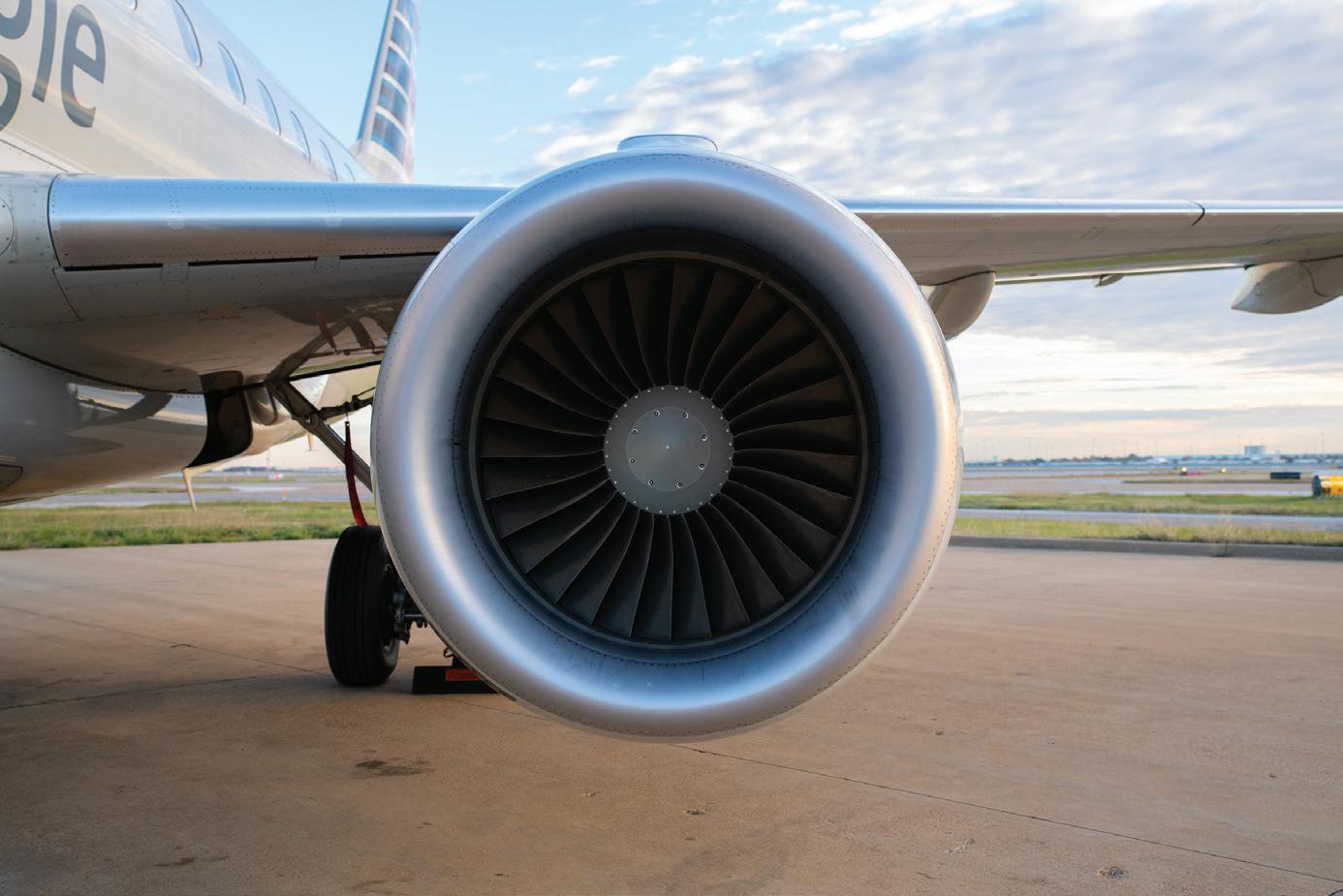




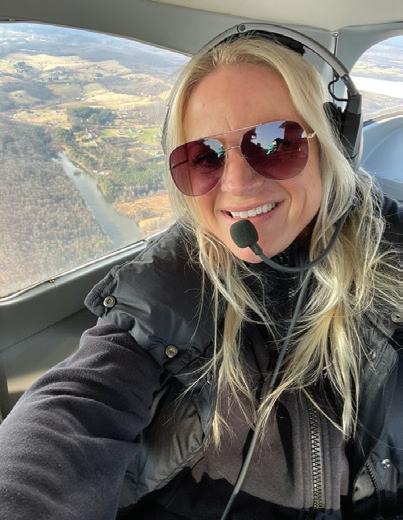
By Terry Arnold

Show me a kid who doesn’t like airplanes, and I’ll show you a kid who doesn’t like Kellogg’s® Froot Loops. What child doesn’t look up at the sky, see an aircraft, and think, “That could be me up there!”
For most, it remains just a dream. But for those with a true passion for flying, the future is bright—provided they study hard, find mentors, and develop a keen interest in STEM (Science, Technology, Engineering, and Mathematics). STEM is an excellent pathway for students to explore career opportunities, location preferences, and competitive salaries.
The aviation industry is growing rapidly, but at the same time, it’s losing experienced workers to retirement in roles critical to making airplanes and helicopters fly. This looming workforce shortage is an important factor for middle school students to consider as they prepare to step ahead by engaging with the world of flight now.
Aviation careers include more than just pilots—they also involve maintainers, designers, managers, and flight control professionals. The Federal Aviation Administration (FAA) projects that over the next 20 years, more than two million employees will be needed to sustain America’s global leadership in aviation.
According to the FAA, careers in STEM fields offer, on average, 26% higher pay and are less likely to face reductions during budget cuts. These benefits motivate students to get involved in STEM programs, and in this case, pursue careers in aviation.
But where will these future aerospace workers come from, especially when today’s youth seem to be gravitating toward fields outside of science, technology, engineering, and math? How can young people learn about aviation and develop an interest in flight and space?
It’s crucial to introduce STEM career opportunities as early as middle school when students begin exploring careers that offer training, experience, and a good living.
STEM Flights, a national nonprofit focused on youth aviation education, was created by retired Air Force Brigadier General Dave Brubaker, or “General Bru,” as he is known. After retiring, General Bru continued to consult for the defense industry, where he witnessed the increasing need for pilots and technical skills in both military and civil aviation. To address the impending workforce shortage, he established a nationwide mentoring program.
General Bru’s mentoring program pairs professional aviation volunteers with students, encouraging them to study STEM and experience real-life flying. In addition to piloting, students participate in missions focused on advanced air mobility, aerospace engineering, and other aviation-related fields.
“My favorite kind of flying is taking kids up who’ve never experienced the joy of being in a small aircraft,” General Bru shared. “I love seeing the wonder and excitement on their faces and the pride they feel when they take control and get a taste of being a pilot. Giving them hands-on experience in actual flight operations motivates them to consider aviation as a career.”
One student eager to explore aviation was Brennan Jingles, a middle schooler from Geismar, Louisiana. Brennan aspired to become a commercial pilot and discovered STEM Flights through an online search. After applying and completing the required forms,
Brennan was paired with volunteer instructor pilot Tony Classen, who took him on a flight near his home.
Brennan admitted he was nervous when he first took control of the aircraft, but once he got the hang of it, he loved it! His flight experience fueled his desire to learn more about flying. He recently completed a 12-week course with the Organization of Black Aerospace Professionals (OBAP), a nonprofit that prepares aspiring aerospace professionals. Brennan continues to study and participate in programs to reach his goal of becoming a commercial pilot.
Another student, Violet Saylors, a seventh grader from Jackson, Michigan, was also excited about her future in aviation. Through STEM Flights, Violet got the chance to take control of an aircraft, something she had always dreamed of. She admitted feeling a bit scared at first, but that fear disappeared when she took full control of the plane with her mentor’s guidance. Violet is now determined to pursue a career as an aerial photographer.
Other students involved in STEM Flights have also gained valuable insight into aviation. Some now work at local airports, while others are attending college to deepen their knowledge of flight operations and business. Several are actively taking flying lessons, with aspirations of becoming licensed pilots and pursuing careers in both military and commercial aviation.
STEM Flights operates in 47 states and is aiming to expand into all 50. Austin Campbell, a retired Coast Guard member, manages the program’s nationwide efforts. As operations manager, Campbell oversees program processes, recruits volunteer mentors, and identifies opportunities to expand this hands-on aviation mentoring program.
“Our volunteer pilot mentors are the heart of our organization,” explained General Bru. “They donate their time, aircraft, and passion to help inspire the next generation. Without them, we wouldn’t be celebrating six years of growth.”
STEM Flights’ expansion has been made possible by grants from private family foundations, individual donors, corporate sponsors, and fundraising efforts. This additional support has allowed the program to increase its resources, improve follow-up after flights, and conduct background checks for volunteers.
Carley Walker, General Bru’s daughter, oversees recruiting both mentors and students. As the national development director and a student pilot herself, she uses her experience in nonprofit marketing to introduce young people to aviation and STEM career paths.
“We were raised to be passionate about life, grateful for our blessings, and to give back,” said Walker. “STEM Flights allows youth to experience the power of flight and the rewarding career opportunities that aviation provides.”
STEM Flights Director of Education, Maria Hoxmeier, noted that the program’s STEM-aviation curriculum incorporates the latest technologies and encourages critical career exploration. “We challenge students to learn about aviation by researching concepts and completing experiments before they’re matched with a pilot mentor,” she said.
“We’re building the next generation of aviation enthusiasts, professionals, and future leaders,” added Walker. As evidenced by Brennan and Violet’s stories, the excitement and passion for aviation is clear.
To get involved in STEM Flights as a student or a mentor, visit stemflights.org to sign up.




By Eric Tellmann
In July 2024, the U.S. Soaring Team made a remarkable appearance at the Junior World Gliding Championships held in Ostrów, Poland. For the first time in U.S. history, a pilot, Thomas Greenhill, brought home a silver medal, soaring to victory in the Standard Class aboard his Discus 2a. Greenhill’s achievement marked a milestone for the team and demonstrated the growing prowess of American gliders on the world stage.
The journey to Ostrów was an adventure in itself, as each pilot and their designated crew traveled to different destinations across Europe to collect their gliders from various countries before converging in Poland. The event attracted pilots from 21 countries, all eager to compete at the highest level of gliding.
The championship began with several practice days, allowing pilots to familiarize themselves with the local conditions. Once the official competition started, the atmosphere was charged with racing excitement. Pilots flew challenging tasks each day, often covering 500 kilometers (310 miles) on multiple tasks, with distances adjusted based on the weather conditions. Each flight averaged 6-7 hours, demanding skill, endurance, and precise navigation.

When pilots ran out of favorable soaring conditions and were unable to complete the day’s task, they would land in open fields. In such cases, the ground crew would quickly spring into action, hooking up the car to the trailer, using GPS to locate the pilot, and finding the best entry point to the field. Upon arrival, the crew would assess the situation and determine how best to disassemble the glider for transport back to the airfield.
After each flight, pilots submitted their flight recorder files for review. Once the scorers analyzed these files and calculated the results, the scores were posted, and pilots eagerly shared their flight experiences with one another, fostering a sense of camaraderie and shared learning.
A highlight of the event was the traditional international night, where each country’s team prepared dishes representative of their home cuisine. The U.S. team served pulled pork sliders topped with RockStar Donuts


BBQ sauce, classic s’mores, and Jack and Cokes. Their offerings were a huge hit, creating buzz and setting the stage for the next day’s flying.
The 2024 Junior World Gliding Championships were a memorable experience, marked by historic achievements, cultural exchange, and the thrill of competition. As the U.S. team reflects on their success, they look forward to soaring to even greater heights in future championships, including Germany 2026.

























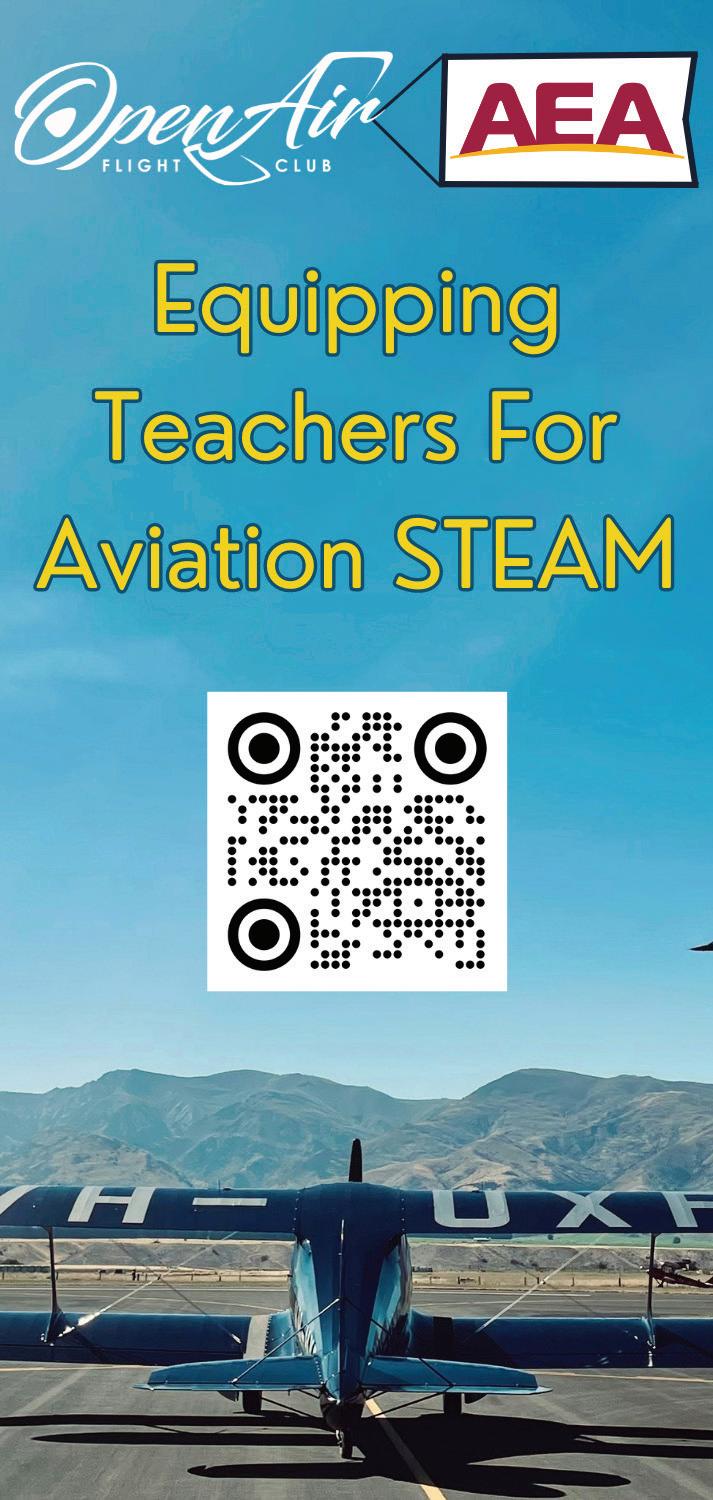
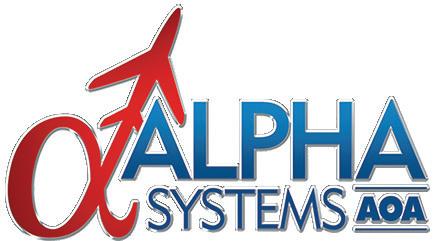









On June 21st, flight simulation enthusiasts, developers, media, hardware manufacturers and more flocked to the Rio Hotel & Casino in Las Vegas, NV for the 5th FlightSimExpo. The expo took place over 3 days, with Friday’s schedule being dedicated to attendee registration and product announcements, followed by 2 days of flightsim-related seminars and an Exhibit Hall displaying the latest hardware, software, and community products.
The flight simulation hobby, which used to be considered niche, has grown considerably over the past few years, with more accessible sims like Microsoft Flight Simulator, DCS, and an updated X-Plane 12 coming to market. With MSFS boasting over fifteen million simmers, this is no longer a niche market. When compared to real aviation, the flightsim hobby is accessible to those who cannot physically fly due to disabilities, time, and budget constraints as well as people of all educational backgrounds. While millions of gamers are using flight simulation for casual entertainment, 33% of FlightSimExpo attendees are certificated pilots and/or using flight simulation as a real-world training tool.
With this growth in the hobby comes growth with the FlightSimExpo event, with 2450 attendees traveling to Las Vegas for this year’s event. This is a 25% increase over last year’s event in Houston. FlightSimExpo appeals to a wide range of simmers, where half of attendees consider themselves Experts or Advanced, a quarter in the Beginner and Novice category, and the other quarter consider themselves Intermediates.
Friday afternoon was dedicated to a host of announcements, with a 5-hour barrage of various hardware and software companies taking the stage to highlight their newly released products and to present surprise announcements.
Bluebird Simulations: CEO Shervin Ahooraei kicked off the announcements by showcasing Bluebird’s upcoming Boeing 757 with a video trailer. Bluebird Simulations, founded in 2020, promises the 757 will be the “most accurate and immersive 757 ever created for flight simulation”. The aircraft has been in development for MSFS for 3 years and has been tested by real 757 pilots to create accurate flight

By Spencer Doyle
dynamics within the simulator. Bluebird has recorded audio from the real aircraft, which will have fully automated systems, accurate night lighting effects, and a fully custom autopilot with 3 FCCs (flight control computers), LNAV/VNAV, and SimBrief integration. Shervin stated that their autopilot will create curved courses as well, which has often been a struggle to achieve within the simulator. The 757 will be a 1 to 1 representation of the real 757 by using a blend of real measurements of the real aircraft, thousands of photos, color scans, and 3D scanning technology. Shervin also showcased their upcoming 767 before announcing a future 787.
Flitesim.com: Fabian Lim was next on stage all the way from Singapore. Fabian has quite an extensive and interesting history with flight simulation. If you have ever doubted whether simulation experience translates well versus real aviation, look no further than Fabian Lim. He is the Founder of Flightschool. sg, which is a flight school that exclusively uses simulators and WingsAcademy.sg, which is a retail flight simulator center. Fabian, a flight simulation enthusiast himself, obtained his PPL in 19 days, his
instrument rating in 10 days, multi-engine in 5 days and Eclipse 500 single-pilot jet rating in 14 days, all due to extensive experience within the flight simulator hobby.
Fabian presented Flitesim.com’s existing and upcoming hardware. The company focuses on higher end force-feedback peripherals. Fabian showed off his CLS 60 & CLS 120 yokes, force feedback stick base, and force feedback rudder. The yokes are a full-sized replica of the Cessna 172 yoke but can be swapped for a Boeing 737-800NG yoke in the future. He also announced the upcoming FC-50 Flight Console, which is a G1000 replica.
Nimbus Simulation Studios: Santiago with Nimbus showed off some very impressive tools for X-Plane that are used for real-life training. Firefighting instructors can utilize this tool to create training scenarios within the X-Plane simulator, allowing students to train in a safe environment. Nimbus Simulation Studios’ mission creation tool allows users to create similar missions to share with others within
the community. They also announced the future development of a 707 and announced/released Charlotte International for X-Plane.
SayIntentions: Brian, the Founder & Lead Developer for SayIntentions presented a video showcase of their AI-driven ATC product. SayIntentions is a very impressive ATC tool that utilizes AI technology. Brian also announced that AI cabin crews are coming to the product and a price reduction from $29.95 to $19.95 per month.
Kav Simulations: James Kavanagh presented new airport LED boards by Kav Simulations; a hardware company focused on meeting the needs of home cockpit builders. These are top-down maps of various airports, with colored LED lights which mark aircraft in real time at the airport. The user can switch these to show real-life aircraft or in-simulator aircraft with the flip of a switch.
WinWing: Tony Lin, with WinWing, took the stage to announce a host of upcoming hardware. WinWing announced several airline panel products for both the Airbus a320 and the Boeing 737, including EFIS displays, MCDUs, ACPs, Transponders, MCPs, etc., all reasonably priced. Tony also showed us their F18 joystick, called the 18 Joystick V2, their Ursa Minor Airline Joystick, which are Airbus sidesticks, and their Cyber Taurus, which is a force feedback option.
SimFly: Roberto Capodieci, presenting remotely, promoted the SimFly simulated economy software product. This runs alongside the simulator, measuring all your statistics and rewarding you according to your performance. You can purchase aircraft and airports with the product and use them to earn their currency, called PAX tokens.
Combat Pilot: Combat Pilot is an upcoming Unreal Engine 5 WW2 simulator based in the Pacific Theater. Developed by Entropy Aero, they announced that the product will release with the Battle of Midway, followed by the Solomon Islands, and much more, with a targeted shelf-life of 20 years.

Slitherine Games: Slitherine announced an upcoming game called Scramble: Battle of Britain. This is a much different take on aviation where the goal was to slow down the flying aspect to bring the focus more on tactics. They managed to achieve this goal by making it turn-based, so the game pauses between each decision the player makes. Scramble is billed as a turn-based tactical dog fighter.
Navigraph: Magnus Axholt took the stage to present the current Navigraph product and its newest features. To the delight of ATC communities such as VATSIM, IVAO and PilotEdge, Navigraph is adding the ability to see online traffic and ATC sectors.
FlyInside: Rick Miller with FlyInside announced two new helicopters coming to MSFS soon, the Rotorway 162F and the Rotorway Jet Exec. Rick is a helicopter pilot himself and has experience flying many of the helicopters that they develop. Rick then announced that FlyInside will develop four different models of the Mosquito helicopter, the XEL, XE, XE 290 and the XET. Following that, they will work on five different Enstrom models, the F28, F28, TH180, 280FX and the 480. Finally, FlyInside has announced four different models of the Gazelle to be released in 2025, the SA-341D, SA-341G, SA-342J and the SA-341L. That is an extensive lineup coming from FlyInside!
Flying Art: Flying Art took the stage next to present their AI generated cabin crew announcements product, called Cabby. This product works with both X-Plane & MSFS platforms, has SimBrief integration, regional based languages, and custom voices. The developer showed an impressive demonstration which utilized AI to translate his wife’s voice into cabin announcements in several different languages.
Tobii Gaming: Thomas Papa was next up with a demonstration of Tobii Gaming’s innovative technology, referred to as “Camera Boost.” Tobii Gaming makes head/eye tracking hardware, known as the Tobii Eye Tracker, and this new technology boosts the motion of the camera the further you look away from the center of the screen. This resolves an issue that otherwise limits your range of motion.



SoFly: SoFly then took the stage to present their existing products, before showing off some new bundle packs, and upcoming software addons for MSFS. New bundles include the Weather Enhancement Pack, World Enhancement Bundle, and the Sim Starter Bundle. Eco Soundscapes was announced as an upcoming addon pack that enhances and adds aircraft sounds, ATC chatter and global ambient sounds such as birds and crickets. SoFly are also entering the cabin announcement space with their newly revealed Cabin Announcement Pro product. Unlike other offerings, SoFly’s Cabin Announcement Pro will be a one-time purchase price instead of a subscription fee.
Laminar Research: Laminar Research, developers of flight simulation platform X-Plane showed us several improvements to X-Plane, far too numerous to name in this space. Suffice to say, they are improving a wide range of features of their simulator, including new graphics, and lighting models, adding synthetic vision to the G1000 avionics, and a new in-game marketplace.
FlyShirley.com: Fly Shirley is an AI copilot tool developed for X-Plane platforms. Since this is AI-generated, you can ask your copilot almost anything, from details around weather conditions, flight plan, or the area in which you are flying. You can also create & share challenges with the community, and the AI copilot will talk you through them, like having a trainer in the seat. Their goal is to eventually utilize this tool in real aviation to promote safety.
Blackbird Simulations: Finally, to close off the lengthy day of announcements, Blackbird released a trailer of their T-6A Texan II, which was made available for purchase immediately following the announcement.
Saturday and Sunday of FlightSimExpo were filled with seminars covering a wide range of topics, from flight planning to flying skills, virtual airlines, virtual ATC to virtual cockpits and PC builds and
content creation. You can even learn more about flying helicopters in a simulator from Rick Miller of FlyInside and Sergio Costa of HeliSimmer.com. All of these are well worth the time, but we are going to focus on arguably the most anticipated event of the weekend, which was the nearly 2-hour presentation for Microsoft Flight Simulator’s upcoming MSFS 2024.
Throughout the day on Saturday and Sunday, attendees can roam the Exhibit Hall, which featured seventy different exhibitors this year. The exhibit hall is the place where you can get firsthand with the latest hardware, software, and add-ons. Often, you can test out products before they are available to the public. There are several giveaways, and many exhibitors often run sales during the event exclusively for attendees. A few exhibitors even have live challenges that you can participate in for prizes.
With so many flight simulator products only being available online, having an opportunity to get your hands on them and physically test them out in-person is an invaluable experience that you just cannot get anywhere else. There are simulators everywhere on the show floor where you can test motion rigs, VR headsets, and the latest hardware and software.
Whether you are a beginner in the hobby or an expert, every flight simmer gets value out of attending the FlightSimExpo. Next year’s event will be held in Providence, Rhode Island on June 27-29, 2025, at the Rhode Island Convention Center. Go to https://flightsimexpo.com/ for more information on registering for the event.
Section Supported by
By Tom Flavin

Michael Rutledge hails from Bettendorf, Iowa, and enlisted in the U.S. Navy in April 1990. He served for three years as a helicopter rescue swimmer, deploying to Desert Storm and Operation Restore Hope in Somalia. In 1993, he applied for Basic Underwater Demolition/ SEAL (BUD/S) training in Coronado, California, and spent the next decade as a Navy SEAL. While serving with SEAL Team ONE, he completed three contingency deployments as an M-60 machine gunner, air operations specialist, and advanced training instructor.
In 2002, after returning from the initial assaults in Afghanistan, Michael transferred from the U.S. Navy to the U.S. Army to become a helicopter pilot,
receiving a direct assignment to the 160th Special Operations Aviation Regiment. His roles included MH-47G Assault/Instructor Pilot, Developmental Test Pilot, and Maintenance Test Pilot Examiner. During his time with the 160th, he completed an additional 16 combat deployments to Iraq and Afghanistan, including several high-profile hostage rescues and leading an element during an assault to capture the world’s most-wanted terrorist.
After 14 years of continuous combat operations, Michael assumed command of the Executive Flight Detachment and Aviation Department at the United States Military Academy at West Point. As commander, he flew the Commanding General, visiting dignitaries, heads of state, and a U.S. president. Michael is rated in six Army helicopters and multiple military airplanes.






















In May 2019, CW4 Rutledge retired after 30 years of active duty and began his next chapter as an aerial applicator. In 2021, he took a step further and founded Rutledge Airborne Applications, providing nationwide aerial firefighting using Single Engine Air Tankers. He also recently acquired Sarita Custom Farm Service, the
F-35 fighters as part of the Navy Legacy Flight Demonstration Team.
Michael and his wife of 30 years, Dena, reside in Casa Grande, Arizona. They have two sons: Joshua (24), U.S. Army, based at Fort Carson, Colorado, and Matthew (20), a student at Grand Canyon University in Phoenix.











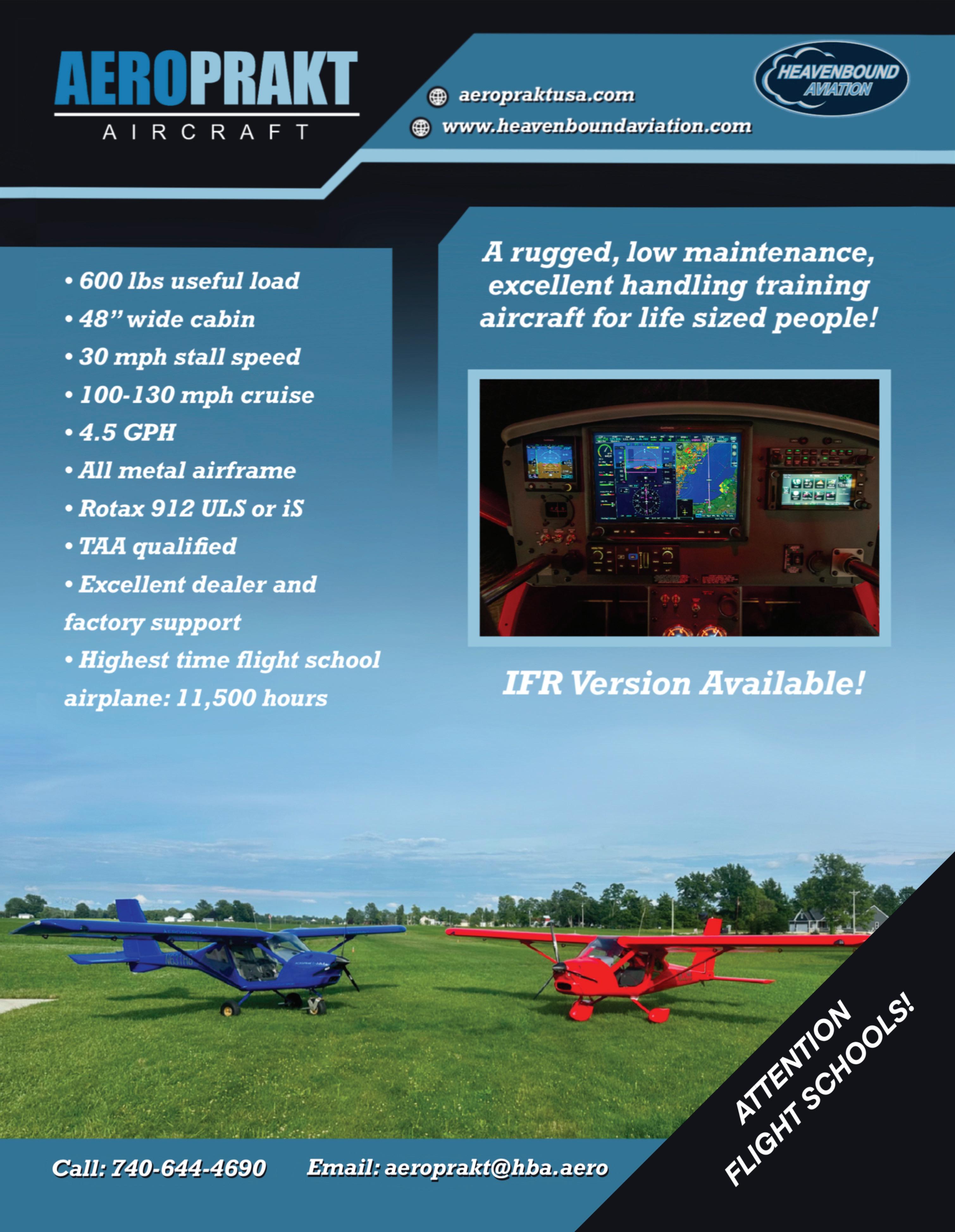
















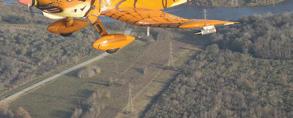





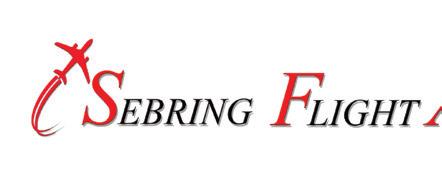




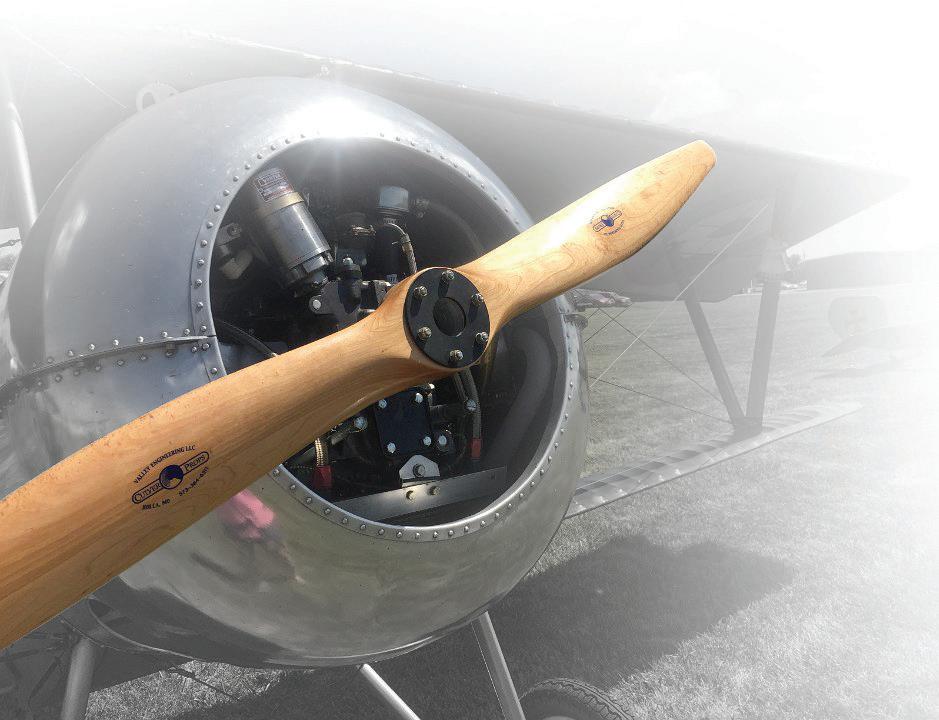




Hands-on experience with a curriculum that combines flight, flight simulator, online and in-classroom training. Train to become a commercial pilot at LIFT Academy. flywithlift.com